IB Business Management IA: 60 Topic Ideas and Tips

Table of contents
- Writing Metier
Selecting the right topic for your IB Business Management IA is a crucial step and a golden opportunity to showcase your understanding and appreciation of the business world.
As someone immersed in assisting students with their academic writing, I cannot stress enough the significance of aligning your IA topic with both the course objectives and your personal interests.
In this ever-changing business environment , especially with the recent impacts of the COVID-19 pandemic, numerous avenues and pressing issues beckon a deeper exploration.
As I know from the general IB criteria, the IA should reflect your grasp of business concepts and demonstrate a keen eye for real-world applications.

Understanding the IB Business Management IA
Before we dive into the plethora of topic ideas that await your exploration, let’s take a moment to understand the essence of the IB Business Management IA.
In my opinion, the IA serves as a platform where you can marry theoretical knowledge with practical insights. It beckons you to step beyond the confines of a classroom and engage with business concepts more tangibly.
The goal is clear: to foster a deeper understanding and appreciation of the contemporary world’s business dynamics. And believe me, once you immerse yourself in a topic that resonates with you, you will find the process enjoyable and aim for that coveted level 7 grade with a newfound enthusiasm.
Now, let me guess, you might wonder, “How do I choose a topic that not only piques my interest but also holds substantial relevance in today’s context?”
Well, fret not, because as someone who is running a company that has guided numerous students in their academic curriculum, my team and I have curated a list of diverse business IA topics that might just spark that perfect idea strictly for you. I’ll share this list of 50+ different topics later in this article.
Working on Business Management Topics
In my experience, working with business management topics offers a rich ground for exploration. For instance, consider exploring the drastic shift in marketing strategies with the advent of technology.
Real-life examples abound, from the surge in influencer marketing to the use of big data in crafting personalized marketing campaigns. Or perhaps you might find yourself intrigued by the concept of “sustainable development” and its influence on contemporary companies.
As I know, many companies nowadays are adopting green initiatives, not just as a part of corporate social responsibility but also as a strategic movement to align with the growing consumer choice for eco-friendly brands.
The main goal here is to choose a topic that intrigues you and allows you to showcase an in-depth understanding of business concepts in a real-world context .

Get help with IB English Internal Assessment
And if at any point you find yourself needing guidance or assistance in choosing a topic or crafting your IA, my business, WritingMetier , is here to assist you with both topic suggestions and internal assessment writing services.
List of Good BM IA Topics
I understand the importance of selecting a topic that not only adheres to the IB criteria but also stands out in terms of uniqueness and depth.
Here are some unusual yet manageable IB Business Management IA topics, and moreover, I’m sharing with you potential RQs that can be used even today:
1. Corporate Social Responsibility (CSR) and Brand Image
How does the implementation of CSR initiatives influence the brand image of tech companies?
2. Psychological Pricing Strategies
What impact do psychological pricing strategies have on consumer purchasing behavior in the fashion industry?
3. Remote Work Culture and Employee Productivity
How has the shift to remote work culture during the COVID-19 pandemic affected employee productivity in IT firms?
4. Green Marketing and Consumer Perception
How does green marketing influence consumer perception and buying decisions in the automobile industry?
5. Gamification as a Marketing Tool
What is the effectiveness of gamification as a marketing tool in enhancing customer engagement for e-commerce platforms?
6. Artificial Intelligence (AI) in Customer Service
How has the integration of AI in customer service improved customer satisfaction in the banking sector?
7. Subscription Box Business Model
What factors contribute to the success of the subscription box business model in the beauty and cosmetics industry?
8. Influencer Marketing and Brand Loyalty
How does influencer marketing influence brand loyalty among millennials in the fashion industry?
9. Blockchain Technology in Supply Chain Management
How can blockchain technology enhance transparency and efficiency in supply chain management for retail companies?
10. Circular Economy and Sustainable Business Practices
How are companies in the manufacturing sector adopting the principles of the circular economy to promote sustainable business practices?
11. Emotional Intelligence and Leadership
What role does emotional intelligence play in effective leadership within healthcare organizations?
12. Augmented Reality (AR) in Retail
How is augmented reality revolutionizing the customer shopping experience in the retail sector?
13. Ethical Sourcing and Consumer Preference
How does ethical sourcing influence consumer preference in the coffee industry?
14. Crisis Management and Corporate Reputation
How do effective crisis management strategies safeguard corporate reputation during product recalls?
15. Employee Wellness Programs and Organizational Performance
What impact do employee wellness programs have on organizational performance in the corporate sector?
16. Social Media Analytics and Market Research
How are companies utilizing social media analytics for market research and product development?
17. Virtual Reality (VR) in Real Estate Marketing
How is virtual reality transforming marketing strategies in the real estate sector?
18. Ephemeral Content and Brand Engagement
What is the role of ephemeral content in enhancing brand engagement on social media platforms?
19. Crowdfunding as a Financing Option
How effective is crowdfunding as a financing option for startup companies in the technology sector?
20. Gender Diversity in Corporate Boards
What impact does gender diversity in corporate boards have on company performance?
Are you ready for more IB BM IA topic ideas? Of course you are. Let’s continue 😉
More Business IA ideas

Here are more unique yet manageable topics along with research questions for your IB Business Management IA:
21. Corporate Storytelling and Brand Identity
How does corporate storytelling enhance brand identity and customer loyalty in the hospitality industry?
22. The Role of Big Data in Business Decision Making
How is big data influencing business decision-making processes in e-commerce companies?
23. The Impact of Brexit on International Business Strategies
How have international business strategies of UK-based companies evolved in response to Brexit?
24. The Gig Economy and Labor Rights
What are the implications of the gig economy on labor rights and job security in the transportation sector?
25. The Rise of Veganism and Food Industry Adaptations
How is the rise of veganism impacting product development strategies in the food industry?
26. The Role of Behavioral Economics in Marketing
How are doctrines of behavioral economics being utilized to enhance marketing strategies in the retail sector?
27. The Impact of Podcasting on Business Marketing
How is the rise of podcasting affecting content marketing strategies for businesses?
28. The Influence of Cultural Intelligence on International Business
How does cultural intelligence influence the success of international business ventures?
29. The Integration of Internet of Things (IoT) in Supply Chain Management
How is the integration of IoT technologies enhancing efficiency in supply chain management?
30. The Role of Corporate Wellness Programs in Employee Retention
How do corporate wellness programs influence employee retention rates in IT companies?
31. The Impact of Urbanization on Retail Business Strategies
How is urbanization influencing retail business strategies and store locations?
32. The Influence of Music on Consumer Behavior in Retail Environments
How does background music influence consumer behavior and spending patterns in retail environments?
33. The Role of Chatbots in Enhancing Customer Service
How are chatbots revolutionizing customer service in the e-commerce sector?
34. The Impact of Sustainable Packaging on Consumer Buying Decisions
How does sustainable packaging influence consumer buying decisions in the FMCG sector?
35. The Influence of Celebrity Activism on Brand Perceptions
How does celebrity activism influence brand perceptions and consumer loyalty?
36. The Role of Emotional Branding in Building Customer Loyalty
How does emotional branding influence customer loyalty in the luxury fashion industry?
37. The Impact of Virtual Teams on Organizational Productivity
How have virtual teams influenced organizational productivity during the COVID-19 pandemic?
38. The Role of Corporate Social Innovation in Business Sustainability
How is corporate social innovation contributing to business sustainability in the technology sector?
39. The Influence of Experiential Marketing on Brand Engagement
How does experiential marketing enhance brand engagement and customer experiences?
40. The Impact of Language Localization on International Marketing Strategies
How does language localization influence the effectiveness of international marketing strategies?
41. The Role of Neuro-Marketing in Consumer Behavior Analysis
How is neuro-marketing being utilized to analyze and influence consumer behavior in the advertising industry?
42. The Impact of 3D Printing on Manufacturing Businesses
How is the adoption of 3D printing technology influencing production strategies in manufacturing businesses?
43. The Influence of Micro-Moments on Digital Marketing Strategies
How are micro-moments reshaping digital marketing strategies for e-commerce businesses?
44. The Role of Business Analytics in Strategic Planning
How is business analytics aiding in strategic planning and decision-making in financial institutions?
45. The Impact of Augmented Reality (AR) on Online Retail
How is augmented reality enhancing the online shopping experience and influencing consumer buying decisions?
46. The Influence of Employee Engagement on Organizational Performance
How does enhancing employee engagement influence organizational performance and productivity in service industries?
47. The Role of Content Curation in Digital Marketing
How is content curation being utilized as a digital marketing strategy to enhance brand visibility and engagement?
48. The Impact of Social Entrepreneurship on Community Development
How is social entrepreneurship contributing to community development and social change?
49. The Influence of Omni-Channel Retailing on Customer Experience
How is omni-channel retailing enhancing customer experience and loyalty in the fashion industry?
50. The Role of Predictive Analytics in Inventory Management
How is predictive analytics being utilized to enhance inventory management and reduce costs in retail businesses?
51. The Impact of Corporate Transparency on Consumer Trust
How does corporate transparency influence consumer trust and brand loyalty in the food industry?
52. The Influence of Ethical Leadership on Organizational Culture
How does ethical leadership influence organizational culture and employee satisfaction in healthcare organizations?
53. The Role of Mobile Wallets in E-commerce
How are mobile wallets influencing consumer purchasing behavior and payment preferences in e-commerce?
54. The Impact of Social Media Influencers on Brand Image
How do social media influencers influence brand image and consumer purchasing decisions in the beauty industry?
55. The Influence of Eco-Friendly Initiatives on Brand Loyalty
How do eco-friendly initiatives influence brand loyalty and consumer preferences in the automotive industry?
56. The Role of Business Intelligence in Competitive Advantage
How is business intelligence being utilized to gain a competitive advantage in the telecommunications industry?
57. The Impact of Employee Training Programs on Organizational Growth
How do employee training programs influence organizational growth and employee performance in manufacturing industries?
58. The Influence of Consumer Reviews on Online Purchasing Decisions
How do online consumer reviews influence purchasing decisions and brand perceptions in the electronics industry?
59. The Role of Corporate Blogging in Brand Awareness
How is corporate blogging being utilized to enhance brand awareness and engagement in the IT sector?
60. The Impact of Green Supply Chain Management on Environmental Sustainability
How is green supply chain management contributing to environmental sustainability in the logistics industry?
These topics align with what you envision, and hopefully, you now have enough ideas to get inspiration.
Tips for Choosing and Researching Your Topic
Selecting the right topic sometimes feels like a Herculean task. In my opinion, the secret to easing this process lies in aligning your BM IA topic with current trends and your interests.
Yes, a topic that resonates with you can fuel your enthusiasm and drive a more insightful analysis.
Now, let’s talk about relevance . In the current business landscape, topics revolving around the implications of the COVID-19 pandemic, the surge in e-commerce, or the increasing focus on sustainable business practices are timely and rich with information.
Drawing from real-life examples , consider analyzing the strategies adopted by businesses to pivot during the pandemic or the role of digital marketing in enhancing brand loyalty during these times.
Similarly, opting for a topic with readily available comprehensive information is a good choice. Trust me, having many reliable sources can significantly streamline the research process, allowing you to craft a well-rounded and insightful Business IA.
If you are also interested, please check a new article about good business management EE topics for IB students.
Crafting a Successful IA
As you may already understand from the previous parts, the foundation of a successful Business and management IA lies in meticulous planning and a clear and understandable research question.
Now, let’s focus on the importance of a well-supported conclusion. Drawing from real-life examples, consider analyzing various case studies to substantiate your arguments, thereby adding depth and credibility to your IA.
Moreover, do not forget about the power of brainstorming and mind mapping. These strategies foster creativity and help unearth unique perspectives that might remain overlooked.
Keep in mind that your IA in BM reflects your understanding and application of business concepts in a real-world context. Therefore, don’t hesitate to seek feedback and refine your topic to align perfectly with the IB objectives.
If you find yourself at a crossroads, remember that assistance is just a click away. At Writing Metier, we specialize in helping students like you with topic suggestions and crafting impeccable IAs, ensuring that your work is both rewarding and successful.
I must emphasize that your topic choice can make or break the whole IB Business Management IA.
In my opinion, crafting a successful IA is akin to nurturing a seed into a full-fledged tree. It requires patience, diligence, and a deep-rooted knowledge of the business dynamics that govern our world today.
More related articles with IB topic suggestions:
- Global Politics IA Ideas
- Literaturature IA Topics
- Math IA Topic Ideas
- Math AA Topics
- Physics IA Topics and RQs
- Bio IA Ideas
- Biology Research Paper Topic Ideas
- Chemistry IA Topics
- Economics IA Topic Ideas
- ESS IA Topics
From years of experience assisting students, I have observed that those who choose topics aligned with their personal interests and the pressing issues of the modern business world often find themselves more engaged and enthusiastic throughout the writing and researching process.
Exactly! A well-chosen topic not only facilitates a smoother writing process but also paves the way for a richer and more insightful analysis.
This is why I encourage you to choose a topic that resonates with you and allows you to showcase a deep understanding of business concepts intertwined with real-world applications.
Always remember, your IA is not just another academic assignment but a golden opportunity to enter the fascinating business world, fostering a lifelong appreciation and understanding of the subject .
Keep in mind, should you need guidance or help with your IB assignments , WritingMetier is here to support you every step, offering expert advice and assistance in both topic selection and crafting a stellar IA.
Free topic suggestions
Vasy kafidoff.
Vasyl Kafidoff is a co-founder and CEO at WritingMetier. He is interested in education and how modern technology makes it more accessible. He wants to bring awareness about new learning possibilities as an educational specialist. When Vasy is not working, he’s found behind a drum kit.
Similar posts
100+ ib extended essay topic ideas for your ease.
One of the very important requirements of an IB diploma is the extended essay. This really helps bring up the total score. And one problem students face here is gathering ideas for their IB extended essay. Here is some guiding information that can help with extended essay topics.
12 ToK Key Concepts | Explained
This write-up is all about TOK concepts, what they are and how essential they are to help you work your way through things. In total, there are 12 TOK concepts. Let's figure out more about each
30 Different TOK Presentation Topic Ideas to Succeed in IB
Given that the TOK essay's structure and the presentation are unlike others, students can find it challenging to proceed with it. You can only do well on the TOK presentation if you have an excellent idea.
37 IB SL Math IA Topic Ideas that Actually Work!
If you are here because you are stuck with an idea for your IB Mathematics Standard Level (SL) essay topic, you have come to the right place. We understand that the IB Math is the toughest subject (no kidding, we feel you) and therefore, we are here to aid you as much as we can.
Acing IB English Language & Literature Paper 1 | A Comprehensive Guide
Learn how to ace your IB English Language and Literature Paper 1 with this comprehensive guide. Discover effective tips and strategies for analyzing texts, developing a thesis, structuring your essay, and writing a compelling introduction and conclusion. Improve your writing skills and boost your chances of success with this essential resource for IB English students.
Breaking the Ivy League Barrier: Can IB Students Get into Harvard?
Wondering if Harvard accepts students from the International Baccalaureate (IB) program? The answer is yes, but it's not easy. In this article, we'll explore what IB students can do to improve their chances of being accepted to Harvard.
We rely on cookies to give you the best experince on our website. By browsing, you agree to it. Read more
IB Business IA Guide - $1000 To Your PayPal If You Score Less Than A 7! 💰
Discover the secrets to nailing your IB Business IA! Get ahead of the game with our comprehensive 2023 Ultimate Guide. Boost your grades now!

Table of content
Ib business management in a nutshell 🥜, ib business ia - a deep dive 🌊, pros of doing a ib business ia, breaking down ib business sl ia 🔨, understanding ib business hl ia 📚, secret business ia tips that no one will tell yeh 💯 , the perfect workplan for a level 7 worthy business ia 🏫, sexy suggestions from our desk 💁.
Hey there, biz wizards!
Need help with your IB Business IA?
Well, aren't you in the right place!
IB Business can be a tough nut to crack, given how dynamic it is, but tackling the IB Business Internal Assessment is another job. And as though that needed to be more, surfing the net only to find bits of information and tips scattered all over makes it all the more troublesome.
We understand that you need to crack your IB Business Internal Assessment with a comprehensive assortment of tips, strategies, and ideas.
Presenting the one-stop guide that will help you nail your IB Business IA. With step-by-step guidance, sample IAs to kickstart the process, and tips/techniques to fix your IA, this guide is your key to unlocking a level 7.
Before we begin, you should check out our premium IB Business course curated by subject experts and top-performing alums!
- IB Business Management SL Video Course & Resources
The IB Business Management course aims to develop students' ability to analyze, discuss and evaluate business activities on different levels by understanding various business management theories and various tools and techniques. It gives students a taste of the dynamic business environment via real-world examples and case studies. It ensures that subject-specific skills (e.g., Financial Analysis) and generic ones (e.g., Critical Thinking) are learned and developed.
To read more on the IB Business Management Curriculum, there's no better resource than the IB itself. Go through this article to understand first-hand what the course's objectives are. Now that we are well acquainted with the subject objectives let's get down to business.
What is the IB Business IA, and how does it benefit students?
The Internal Assessment is where students get the opportunity to use their knowledge and skills to pursue their interests. Although the IA is compulsory for SL and HL students, there's a difference.
While the SL students must prepare a Written Commentary , the HL students must produce a Research Project . The HL students must base their project on primary Research (gathered from the investigated organization). SL students' written commentary needs to be based on secondary Research.
As listed by the IB, examples of Primary and Secondary data sources include
- Primary Sources
- Responses to questionnaires (students should include a blank copy of the questionnaire and a tally/ summary of results)
- Results of surveys
- Discussions with Business Stakeholders
The research findings should be summarised, and relevant documents (interview transcript, evaluations) should be added to the appendix.
- Secondary Sources
- Articles from the local, national or international press
- Business accounts
- Business plans Extract from company websites.
- Transcripts of a relevant audio-visual file
- Financial reports
- Government and other statistics
- Journal publications
- Market research surveys
- Web-based surveys
Learners tend to grasp information relatively faster in the IB business Internal Assessments since maximum study content is relevant to everyday life, helping learners create comparisons.
The emphasis in IB Business IA is on
- how well do you carry out your research
- the conciseness of arguments put up
- and the real-time case analysis of the chosen company/organization.
Students pursuing IB business develop critical reasoning, practical, cognitive, and judgment abilities.
The IB Business IA examines an organization from any industry and the social-economic and political environments in which it functions.
The IA works with issues that arise inside businesses, where students gain a reasonable understanding via case studies. With a fresh and objective point of view on enterprises and overall variety, they have a more excellent grasp of the industry surrounding them, both worldwide and regionally.
Students working on their IB Business IA will study a business's fundamental ideas and processes while learning about ethics and corporate social responsibility. With this help, learners begin to evaluate, debate and develop brief data on local, national, and worldwide business activity.
Below is a coherent breakdown of SL and HL IA requirements, criteria, etc. Understanding the highlights will help you complete half the IA task!
If you've opted for IB Business SL, your IA will be a Written Commentary, and your work will center around secondary Research. This commentary will make up 25% of your total grade. All the points you need to take care of are listed below .
- A real business issue about an entire organization should be selected.
- Primary Research may be used for support.
- The title of your commentary should be framed as a research question.
- Adhere to the word limit of 1500 for the commentary.
- The commentary should comprise analysis, evaluation, and discussion of the findings. The conclusion should give a solution/answer to the commentary question.
- 3-5 fully referenced supporting documents and additional sources in the bibliography.
- The content of the commentary should be structured and well-presented. Starting with the introduction, which states the business issue at hand and gives background information about the organization, the next part is the body of your work. The body should present the findings from the supporting documents and, most importantly, analyze them with the help of business theories and business tools and techniques. This must be done in the context of the question, and a clear link must be established. Finally, the conclusion should answer the explored question and discuss aspects that must be fully answered.
To work in the right direction, it is essential to understand the marking/grading standards set by the IB. The criteria against which your Business SL IA will be assessed are as follows
- Supporting documents (Levels - 0,1,2,3,4)
- Choice and application of business tools, techniques, and theories (Levels - 0,1,2,3,4,5)
- Choice and analysis of data and integration of ideas (Levels - 0,1,2,3,4,5)
- Conclusions (Levels - 0,1,2,3)
- Evaluation (Levels - 0,1,2,3,4)
- Structure (Levels - 0,1,2)
- Presentation (Levels - 0,1,2)
Now that you know the deets, here's an annotated level 7 worthy IB DP Business SL IA published by the IB . Please give it a good read to better understand how to go about your exploration.
For your Business HL students, your IA also weighs 25% of your total grade. Your IA will be a Research Project based on primary research obtained/collected from the organization under investigation. Everything that you need to take care of is listed below .
- Take up an actual issue/business decision in the context of an entire organization or a range of organizations.
- Secondary research may be used for support.
- The title of your project needs to be framed as a question. Your task is divided into the Research Proposal and the Written Report. The word limit should be at most 500 and 2000 words for the two sections.
- Research Question
- The proposed Methodology includes the rationale for the study, areas of the syllabus to be covered, possible sources of information, organizations and individuals to be approached, methods to be used to collect and analyze data, the reason for choosing them, the order of activities and timescale of the project.
- Anticipated difficulties, such as limited or biased sources
- Action plan
- Acknowledgments
- Contents Page
- Abstract (max word limit-200 (not included in the word count of the Written Report))
- Introduction
- Methodology, Findings, and Results
- Conclusion and Recommendations
- References and Bibliography and Appendices.
The HL IA criteria are nine in total. While criterion A is used to assess the Research Proposal, criteria B-I are used to evaluate the Written Report.
- Criterion A - Research Proposal (Levels - 0,1,2,3)
- Criterion B - Sources and data (Levels - 0,1,2,3)
- Criterion C - Use of tools, techniques and theories (Levels - 0,1,2,3)
- Criterion D - Analysis and Evaluation (Levels - 0,1,2,3,4,5,6)
- Criterion E - Conclusion (Levels - 0,1,2)
- Criterion F - Recommendations(Levels - 0,1,2)
- Criterion G - Structure (Levels - 0,1,2)
- Criterion H - Presentation (Levels - 0,1,2)
- Criterion I - Reflective Thinking (Levels - 0,1,2)
You should refer to this document to better understand the descriptors of the assessment criteria levels.
And here's an annotated high-scoring Business HL IA published by the IB . The more you refer, the better your clarity.
Obtaining a 7 in just about any IB Business IA topic will always be among the most challenging tasks an IB student may face, especially those attempting to get admission to elite institutions or universities. This is also true for IB Business IA. Nail IB discovered that the most challenging obstacle students face in achieving high scores in the Business IA involves utilizing analytical tools. To put it in simple terms, students frequently make the error of conducting a ton of research but need to relate it to the given research topic.
- Make sure you form a relevant link between your analytical approach and the chosen IA report topic. When starting the report, do not mention why this particular argument was selected and the strategy applied. You must conduct a detailed analysis that adds value to your topic.
- Conduct the analysis appropriately and thoroughly, demonstrating that you understand its aim. You can look at numerous business IA sample pdf here for a better understanding of how to go about the entire report and the right way to put across relevant arguments.
- After you've finished each approach, provide a note about what you learned about your proposed solution. After each analysis is completed, do a quick review. State the key results that are relevant to your answer. The goal here will be that by the time your teacher reaches the overall conclusion, they will already know your level of understanding.
- Ask, ask and ask again - No amount of google searches can answer your queries the way your teacher can. Understand that your teacher is always there to help you improve your chances of getting a band 7. It is critical, particularly in IB, to seek the teacher's limitless wisdom; trust us, it is worth it. When asking questions, you're not just clearing your doubts but also giving your brain new information and a fresh viewpoint, which are extremely useful to you and your IB business IA score. Look for clarifications. Develop an interest in what you're studying. Consider how most of the notions throughout the course may be used in the actual world. This is an excellent technique to get your teacher to share information!
- Get your research documents rights - The number of supporting research papers mentioned in the IB business IA criteria is 3-5. These supporting papers are pertinent to the question under consideration. These papers should be recent and written within the previous two years, not preceding that. Accounting records, media articles, web publications, and other credible information are also encouraged. These papers must include a broad spectrum of views and standpoints. The bodily parts that were identified and utilized must be emphasized accordingly.
- Calling into question the data you used throughout your analysis should be part of the evaluation process. Remember to have at least two quantitative and two qualitative analytical tools to give credibility to your arguments.
- All assessments regarding the significance of propositions must be supported by evidence.
- The structure of supporting papers should be evaluated, and so should the grounds for the given research query's existence.
- In your conclusion, remember that your commentary has to lead to a decision.
- Conclusions must be a natural extension of the conducted analysis and its explanations. They should stand relevant, backed up by evidence from the accompanying sources, and address the chosen question directly.
- The word limit for the IB Business SL IA is 1500, with the number of words noted on the first page. Regarding IB Business HL IA, the Research Proposal should be 500 words, while the word limit for the Written Report is 2000 words. Remember, do not beat around the bush. A single paragraph of irrelevant or extra data will completely digress the report. Thus, the comments should always support or focus on the highlighted situation or question. Through the discussion, subject-oriented vocabulary must be utilized. This showcases that your conference addresses the given question throughout.
- For Business SL, all corroborating papers of your primary research and any references utilized must be accompanied by a bibliography. Secondary data may be used for support for Business HL. Your preliminary research details should be mentioned in the appendix. The supporting documents are a critical piece of your puzzle, so examine them thoroughly.
- Choose a topic keeping your strengths in mind - Make a mental map of the themes in your curriculum that you'd like to learn more about, along with companies that you're willing to take part in or deal with frequently. Selecting a company whose statistics are widely or easily obtainable for you to utilize in your investigation is an intelligent choice. Cross-reference those themes and companies, then come up with several research problems. Ensure you clarify how you conduct analyses and what this implies for a competitive or profitable firm. Its marketplace in case your topic includes broad phrases like competitive, dynamic or successful.
- Include relevant factors in your evaluation - Your research has to be the center of your evaluation. The assessment should be logical and relevant to the business and its principles. In addition to that, your analysis and interpretation should be backed up by sufficient evidence, and the findings must be based on your evaluation. The conclusion should provide an answer to your core evaluation. Suggestions for the topic's future activities and suggestions for further research should always be offered (It is essential to give tips wherever necessary). Analytical and critical reflection must also be present in the evaluation section.
- Understand the aim of your rationale - The rationale is not to prove or justify why you seem interested in the topic. Instead, cover why your chosen company is the right fit for your case. Let's take, for instance, the firm is now focusing on enhancing the quality of goods and services, and your Business IA is connected to boosting performance. Here, you are supposed to have a reference to showcase the same. This demonstrates to the teacher that your effort is worthwhile and noteworthy.
The IB business IA report is demanding, no doubt about that. However, losing hope or lowering your expectations will get you nowhere. Thus, aim for scoring a 7! There is no silver bullet for scoring a seven since it always boils back to actual effort and perseverance.
- Keep records, practice questions, and review related material handy. It would help if you felt like a company leader to succeed in IB business IA. You must provide answers to every problem or question in the corporate world. Use journal articles and case studies to put this strategy into practice. Put yourself in the shoes of a director or an advisor.
- Do not lag! As your study will depend heavily on individuals and factors from outside the school setting, you should begin your internal review on schedule. The last thing you need is conducting late research, cramping up your nights, and not thoroughly planning the entire report. Make an action plan, divide each stage of the information (like research, analysis, writing, references, etc.) by weeks and give undivided attention to the task at hand. Thus, getting started on your coursework as soon as possible is imperative.
- Make sure you're familiar with the course material. This will aid in developing your plan; you may either begin by working on themes or focusing on the basic principles. Keep up with the latest business news from the day your curriculum starts. This will help you save time when picking a company for your IA since you will already be aware of companies and their recent updates. Every company has its approach to running its operations. Reading the most recent business news will help you comprehend each organization's various techniques, thus helping you pick the best out of all.
- Don't Charge-in Aimlessly. It's incredibly beneficial to invest serious effort into understanding what to compose and how your IB business IA topic would develop in writing. It would help if you had a general notion of what you want to accomplish before starting. It would help if you were alright as long as you have a general idea of what you want in your IA. Making a one-page outline with primary headings and subheadings and writing down some thoughts will help you channel your ideas.
- Mention some of your research's shortcomings. There should be at most one, if not two. Demonstrate that you've thought deeply about your internal assessment. You might talk about any inconsistencies in your research and why they exist.
- Since the entire HL Internal Assessment revolves majorly around primary research, it's a good idea for learners to look at relatively small, local firms. There's a better possibility you'll be able to schedule conversations and obtain specific information, such as cash flow figures.
- As an IB student completing the IA, you'll have to emphasize constructing comments, picking which argument on an organization might effectively back your claims, and looking for any potentially contradictory information. This combination of contradictions supported by your solutions/suggestions is advantageous to your evaluation.
- Before conducting primary research on your specific firm, looking for secondary sources or asking where you would obtain additional information about them is suggested. Some instances could be in covered print publications, or the mainstream press profiled them.
- Create a statement/argument at least 250 words long for every source you mention. This number may vary based on the supplementary or primary resources available. Still, the objective would be that the IA should be a single and well-supported argument.
- Whatever you discover in the analysis and how you apply it will determine the quality of your work. Remember that your work should flow smoothly and not appear like a poorly articulated argument accompanied by sources cited as evidence rather than facts for the idea.
- Your teacher will critique your IA original proposal. Don't be too concerned. After all, it's the first version, and no one ever wrote a flawless first copy. Accept the teacher's criticism carefully, evaluate whatever they said and wrote, and above all, pay attention to the suggestions they make for your progress. This is precisely what will get you a couple of grades higher.
- As per the IB business IA format, you will have to figure out where you'll place your sources and which referrals go where and for what purpose. Ensure you're correctly referencing and utilizing the materials you've learned about to avoid plagiarism. This is why it's crucial to plan.
- You must do an analysis that tackles a problem that an organization is experiencing or examine a choice that an organization is about to make. In addition, you must write a study proposal that may be utilized as a critical project plan and can be displayed as an implementation strategy.
- You must do an analysis that tackles a problem that an organization is experiencing or examine a choice that an organization is about to make. In addition, you must write a study proposal that may be utilized as a critical project plan and can be displayed as an implementation strategy.
It does not end here. Business IA HL and SL prep is a never-ending process, but you should still explore it. Remember to have fun in this journey of becoming a business genius. You can show why the given choices were made or what techniques using concepts and substance may be used. Also, continue to examine firms critically daily.
To wrap things up, here's a c omplete IB DP Business Management Guide published by the IB. I t will come in handy throughout your Business Course journey.
That's all for now! We hope this comprehensive guide answers your queries about IB Business IA! Whenever stuck, Nail IB will be there to your rescue. You can explore our plan or get in touch with IB professionals here.
Happy learning!
To wrap things up, here's a complete IB DP Business Management Guide published by the IB. It will come in handy throughout your Business Course journey.
IB Resources you will love!
55234 + free ib flashcards, 159 + free ia samples, 3965 + ib videos by experts, 20099 + ib sample practice questions, ib resources for 30 + subjects.

IB Business IA Guide

The blog post titled "Understanding the IB Business IA" on IB Pros provides valuable insights into the International Baccalaureate (IB) Business Internal Assessment (IA) process. This article aims to guide IB students in choosing appropriate topics, conducting thorough research, and structuring their IAs effectively. It also offers tips for writing a strong introduction, making recommendations, reflecting on the research process, and editing and proofreading their work.
Written in an academic style that is objective and impersonal, this resource eliminates personal pronouns while providing clear guidance for IB students. By following the suggested steps outlined in this article, students can improve their understanding of the IB Business IA requirements and ensure they meet the necessary criteria set by examiners.
This informative blog post caters to an audience seeking safety by providing reliable information and step-by-step instructions to navigate through this challenging aspect of their studies successfully.

Key Takeaways
- The blog post on IB Pros provides step-by-step guidance for IB students in selecting a topic, conducting research, and structuring their IB Business IA.
- The IB Business IA assesses students' understanding of business concepts and their ability to apply them in real-world contexts.
- Choosing the right topic is crucial and it should be relevant, feasible, and interesting, while also aligning with personal interests and career aspirations.
- The selected topic should allow for in-depth analysis of key business concepts, be relevant to the business environment and current market trends, and be feasible within the given time frame and resources available.
Understanding the IB Business IA
The IB Business IA plays a crucial role in assessing students' understanding of business concepts and their ability to apply them in real-world contexts. It is an opportunity for students to demonstrate their knowledge, critical thinking skills, and analytical abilities by investigating a business issue or problem. The IA requires students to conduct research, analyze data, and make recommendations based on their findings. This process allows students to develop a deeper understanding of the complexities of the business world and prepares them for future academic pursuits or professional endeavors.
Choosing the right topic for the IB Business IA is essential as it sets the foundation for the entire project. Students should select a topic that is relevant, feasible, and interesting to ensure they stay motivated throughout the process. It is important to choose a topic that allows for sufficient data collection and analysis while also considering ethical considerations. Additionally, selecting a topic that aligns with personal interests or career aspirations can enhance engagement and depth of analysis.
By carefully selecting a suitable topic, students can maximize their learning experience during the IB Business IA. It provides an opportunity for students to delve into real-world business issues and gain valuable insights into various aspects of business management.
Choosing the Right Topic
When selecting a suitable topic for their IB Business IA, students should carefully consider a range of options that align with the course syllabus and offer potential for in-depth analysis. It is essential to choose a topic that allows for the application of business theories and concepts while providing ample opportunities for research and data collection.
To ensure that the chosen topic meets these criteria, students should keep the following considerations in mind:
- Relevance: The topic should be relevant to the business environment and current market trends. This ensures that there is sufficient information available for analysis and evaluation.
- Feasibility: Students should select a topic that can be researched within the given time frame and resources available. It is important to choose a topic that offers access to primary data sources or secondary data that can be analyzed effectively.
- Ethical considerations: Topics involving sensitive issues or questionable ethical practices may not be suitable for an audience seeking safety. Students should avoid topics that could potentially harm individuals or organizations involved.
- Scope for analysis: The chosen topic should allow for in-depth analysis, allowing students to demonstrate their understanding of key business concepts such as marketing strategies, financial management, or human resource planning.
By carefully considering these factors, students can select a topic that sets them up for success in conducting their research and producing a comprehensive IB Business IA report.
Read More About:
How To Stay Motivated In The IB
How To Stay Organized In The IB DP
How To Stay Sane: A Promising Guide To Stress Management In The IB DP
How To Tackle The Extended Essay
How To Write A College Application Essay
Conducting Research
Conducting research in the IB Business IA involves systematically gathering and analyzing relevant data to support an objective analysis of the chosen topic. It is crucial to approach this process with a methodical mindset, ensuring that all information gathered is accurate and reliable. To begin, it is important to identify credible sources such as academic journals, reputable websites, and industry reports. These sources provide valuable insights into the chosen topic and help establish a strong foundation for the IA.
Once suitable sources have been identified, it is necessary to carefully evaluate and analyze the information collected. This includes critically assessing the validity and reliability of the data, identifying any biases or limitations present, and drawing meaningful conclusions from the findings. Additionally, statistical tools can be employed to further enhance the analysis by providing quantifiable evidence to support arguments.
Throughout the research process, it is essential to maintain objectivity and avoid personal biases or opinions. By adopting an impersonal approach, students are able to present a balanced view of their chosen topic while ensuring that their analysis remains grounded in factual evidence.
Conducting research for the IB Business IA requires systematic data collection and objective analysis. By following these steps diligently and employing critical thinking skills throughout this process, students can produce well-rounded IAs that effectively address their chosen topics.
Moving forward onto structuring your IA…
Structuring Your IA
To effectively structure your IB Business IA, it is important to organize your analysis in a logical and coherent manner, ensuring that each section flows seamlessly into the next. This will not only make your IA easier to navigate for the reader but also help you present your ideas clearly and concisely.
One way to structure your IA is by following a traditional essay format, with an introduction, body paragraphs, and a conclusion. In the introduction, provide background information on the topic and state the purpose of your IA. The body paragraphs should be divided into sections that explore different aspects of your research question or hypothesis. Each section should have a clear heading and focus on one specific point or argument. Finally, in the conclusion, summarize your findings and discuss their implications.
By structuring your IA in this way, you ensure that each part of your analysis is given proper attention and that there is a logical progression from one idea to another. This helps maintain clarity throughout the document and allows readers to easily follow along with your thought process.
In order to write a strong introduction for your IA, it is important to grab the reader's attention from the start by providing an engaging opening statement or anecdote related to your research question.
Writing a Strong Introduction
Crafting an engaging opening statement or anecdote related to the research question is crucial in writing a strong introduction that captivates and maintains the audience's interest. The introduction serves as the gateway to the research study, setting the tone for what follows and providing a preview of its content. To effectively hook the audience, consider incorporating these elements into your introduction:
- Start with a thought-provoking quote that relates to the topic.
- Present a surprising statistic or fact that grabs attention.
- Share a relevant real-life scenario or example that illustrates the importance of the research question.
- Introduce a problem or challenge that needs addressing, highlighting its significance.
- Pose a rhetorical question that piques curiosity and encourages reflection.
By utilizing these techniques, you can create an introduction that not only captures your audience's attention but also establishes credibility and relevance. As we move on to analyzing and interpreting data, it is essential to ensure that our methods are rigorous and reliable in order to draw accurate conclusions from our findings.
Analyzing and Interpreting Data
Having established the importance of a strong introduction in the previous subtopic, we now turn our attention to the subsequent step in crafting a compelling IB Business IA: analyzing and interpreting data. This phase involves extracting meaningful insights from the collected data and presenting them in a clear and concise manner.
Data analysis forms the backbone of any business research project, providing evidence for decision-making and strategic planning. By employing statistical tools and techniques, such as regression analysis or hypothesis testing, analysts can identify patterns, trends, and correlations within their datasets. These findings enable researchers to draw conclusions that inform their research questions or hypotheses.
Interpreting data requires objectivity and precision to ensure accurate conclusions are drawn. It is crucial to approach this process with an academic mindset, focusing on empirical evidence rather than personal bias or opinion.
In the subsequent section on presenting data effectively, we will explore various methods for visually representing information that enhance understanding and facilitate communication. Understanding how to present data in a clear and engaging manner allows businesses to effectively communicate their findings to stakeholders while ensuring transparency and accountability throughout the research process.
Presenting Data Effectively
The effective presentation of data is essential for facilitating understanding and promoting transparency in the research process, as stakeholders can easily grasp the insights conveyed through visually represented information. To ensure that data is presented effectively, it is important to consider the following:
- Clear and concise visualizations: Data should be presented in a way that is easy to understand, avoiding cluttered or complicated visuals. This helps ensure that the audience can quickly interpret the information without confusion.
- Appropriate use of color: Color can be used to highlight important points or distinguish different categories within the data. However, it is crucial to choose colors wisely and consider accessibility standards to ensure that all individuals can perceive the information accurately.
- Use of appropriate charts and graphs: Different types of data require different types of visual representations. Choosing the right chart or graph ensures that the data is effectively communicated and understood by the audience.
- Proper labeling and titles: Clear labels and titles help provide context and guide interpretation, ensuring that viewers understand what they are looking at.
By presenting data effectively, researchers can enhance communication with stakeholders and promote informed decision-making processes based on reliable information. Transitioning into applying business concepts and theories will further deepen our understanding of how data analysis supports strategic decision-making in organizations without compromising safety measures.
Applying Business Concepts and Theories
This discussion will focus on the importance of demonstrating understanding of key business concepts and applying relevant theories to your research question. By effectively demonstrating your understanding of these concepts, you can showcase your knowledge and expertise in the field. Additionally, by applying relevant theories to your research question, you can provide a solid foundation for your analysis and strengthen the overall validity of your findings.
Demonstrating your understanding of key business concepts
To effectively demonstrate understanding of key business concepts, it is crucial to employ an academic writing style that is objective, impersonal, and devoid of personal pronouns. This style allows for a clear and unbiased presentation of information, ensuring that the audience receives accurate and reliable knowledge. By using language appropriate for an audience seeking safety in their research, one can provide a sense of reassurance and credibility. Such an approach fosters trust in the analysis being presented and encourages readers to engage with the content further. In the subsequent section about applying relevant theories to your research question, we will explore how these concepts can be practically implemented to enhance business decision-making processes.
Applying relevant theories to your research question
Applying relevant theories to a research question provides a practical framework for enhancing business decision-making processes. By utilizing established theories, businesses can gain insights into various aspects of their operations and make informed choices. These theories serve as tools that enable managers to understand the complexities of different situations and guide them in formulating effective strategies. For example, applying Porter's Five Forces model allows businesses to analyze the competitive forces within an industry and develop appropriate responses. Similarly, using Maslow's Hierarchy of Needs theory helps companies identify and meet the needs of their target market more effectively. Incorporating such theories into research questions enables businesses to delve deeper into understanding consumer behavior, market dynamics, and other critical factors that influence success. This ultimately leads to improved decision-making and increased competitiveness in the marketplace.
Transitioning into the subsequent section about making recommendations, it is crucial for businesses to leverage these theoretical frameworks in order to devise actionable suggestions for improvement.
Making Recommendations
In this discussion, we will focus on the importance of offering practical and feasible solutions based on the findings of our research. It is crucial to consider the potential impact of our recommendations as well. By adopting an academic writing style that is objective and impersonal, we can effectively convey our suggestions without relying on personal pronouns.
Offering practical and feasible solutions based on your findings
One possible solution that can be implemented based on the findings is to establish a mentorship program within the organization. This program would pair experienced employees with new hires or those in need of guidance, providing them with ongoing support and advice. The mentorship program would offer several benefits:
- Knowledge transfer: Mentors can share their expertise and industry insights, helping mentees develop necessary skills and knowledge.
- Professional development: Mentees can receive personalized guidance, setting clear goals and working towards their career advancement.
- Increased employee engagement: Mentorship fosters a sense of belonging and connection, leading to higher job satisfaction and retention rates.
- Enhanced safety awareness: Mentors can emphasize the importance of safety protocols, ensuring mentees are well-informed about potential risks.
By considering these solutions, organizations can take proactive steps towards improving safety practices and fostering a culture of continuous learning. This sets the stage for considering the potential impact of these recommendations on organizational growth and productivity in the subsequent section.
Considering the potential impact of your recommendations
Considering the potential impact of implementing a mentorship program within the organization, it is crucial to evaluate how this initiative can contribute to improved safety practices and foster a culture of continuous learning. A mentorship program can provide an avenue for experienced employees to pass on their knowledge and skills to new hires or less experienced staff members. By pairing mentors with mentees, organizations can ensure that safety protocols and best practices are effectively communicated and implemented throughout the workforce. This not only enhances workplace safety but also promotes a sense of responsibility among employees towards maintaining a safe working environment. Furthermore, mentorship programs encourage open communication and collaboration between different levels of employees, facilitating the exchange of ideas and fostering innovation in safety practices. Reflecting on the research process, it is essential to consider how stakeholders perceive such initiatives and identify potential barriers to successful implementation.
Reflecting on the Research Process
Throughout the research process, it is essential to reflect on the steps taken and decisions made in order to gain a deeper understanding of the findings. Reflection allows researchers to evaluate their methods, identify biases, and consider alternative perspectives. By critically analyzing their work, researchers can ensure that their findings are reliable and valid.
One important aspect of reflecting on the research process is examining the sources used. Researchers should assess the credibility and relevance of each source to ensure that they are using accurate and trustworthy information. Additionally, evaluating any potential bias within these sources helps researchers maintain objectivity in their analysis.
Another crucial element of reflection is considering any limitations or weaknesses in the research design. Every study has its constraints, whether they be time constraints, resource limitations, or ethical considerations. Reflecting on these limitations helps researchers understand how they may have impacted the findings and provides insights for future studies.
Reflection also involves contemplating any unexpected results or inconsistencies found during the research process. These findings can lead to new questions or avenues for exploration. Moreover, reflecting on unexpected results enhances researchers' ability to interpret data accurately.
Reflecting on the research process enables researchers to enhance their understanding of their findings by evaluating sources used, identifying biases, considering limitations, and exploring unexpected results. This critical self-assessment ensures that conclusions drawn from the research are robust and reliable. Moving forward into the section about editing and proofreading…
Editing and Proofreading
When editing and proofreading your IA, it is essential to review the document for clarity, grammar, and coherence. This involves checking that the ideas are presented in a logical order and that there are no grammatical errors or confusing sentences. Additionally, seeking feedback from peers or teachers can provide valuable insights and suggestions for improvement.
Reviewing your IA for clarity, grammar, and coherence
To ensure the clarity, grammar, and coherence of your IA, it is essential to thoroughly review and edit the content using an academic style of writing that is objective, impersonal, and devoid of personal pronouns. This will help you convey your ideas effectively and maintain a professional tone throughout your work. When reviewing your IA, consider the following:
- Structure: Ensure that your IA has a clear introduction, body paragraphs with logical flow of ideas, and a conclusion that summarizes your main points.
- Grammar: Pay attention to sentence structure, verb agreement, punctuation usage, and proper use of tenses.
- Coherence: Check for consistent use of terminology and cohesive transitions between paragraphs.
By reviewing your IA for clarity, grammar, and coherence using these guidelines, you can enhance the overall quality of your work. Seeking feedback from peers or teachers can further strengthen your IA by providing valuable insights and perspectives on areas that may require improvement.
Seeking feedback from peers or teachers
Seeking feedback from peers or teachers can provide valuable insights and perspectives on areas of improvement, thereby enhancing the overall quality of your IA. By sharing your work with others, you open yourself up to constructive criticism that can help identify any weaknesses or blind spots in your analysis. Peers who are also studying the same subject may offer fresh ideas or alternative viewpoints, which can enrich your understanding and strengthen your arguments. Teachers, on the other hand, possess a wealth of knowledge and experience in guiding students through the IA process. Their feedback can serve as a valuable resource for refining your research question, improving data analysis techniques, or suggesting additional sources for further investigation. Incorporating feedback from both peers and teachers ensures that you have considered multiple perspectives and maximized the potential of your IA.
Transitioning into the subsequent section about 'tips for success,' it is important to approach seeking feedback with an open mind and a willingness to learn from others' suggestions.
Tips for Success
When it comes to success in managing your time effectively, seeking guidance and support from your teacher or classmates is crucial. By seeking their advice and input, you can gain valuable insights on how to prioritize tasks and allocate your time efficiently. Additionally, their support can help you stay motivated and accountable for meeting deadlines and achieving your goals.
Managing your time effectively
Efficient time management is crucial for successfully completing the IB Business IA. By effectively managing your time, you can ensure that all aspects of the project are given sufficient attention and completed within the given timeframe. To help you manage your time more efficiently, consider implementing the following strategies:
StrategiesBenefitsPrioritize tasksHelps focus on important tasksCreate a scheduleProvides structure and prevents procrastinationBreak tasks into smaller partsMakes them more manageable and less overwhelmingSet deadlines for yourselfIncreases accountability and motivationAvoid multitaskingEnhances concentration and productivity
By incorporating these strategies into your routine, you can optimize your time management skills and stay on track throughout the IB Business IA. Seeking guidance and support from your teacher or classmates will further enhance your understanding of the project requirements and ensure a successful outcome.
Seeking guidance and support from your teacher or classmates
Collaborating with knowledgeable individuals, such as teachers or classmates, can provide valuable guidance and support for navigating the complexities of the IB Business IA. Seeking guidance from experienced teachers or engaging in discussions with classmates who share a common goal can enhance one's understanding of the project requirements and expectations. This collaboration offers several advantages:
- Access to different perspectives and insights.
- Opportunities for brainstorming and generating innovative ideas.
- Clarification of doubts or misconceptions.
- Constructive feedback on work progress.
- Sharing of resources and study materials.
Engaging in these collaborative efforts can foster a sense of community, promote learning, and reduce feelings of isolation or overwhelm during the IA process. By seeking guidance from trusted sources, students can ensure their safety by adhering to ethical guidelines, avoiding plagiarism, and producing high-quality work that meets academic standards.
Frequently Asked Questions
How can i effectively manage my time while working on my ib business ia.
To effectively manage time while working on the IB Business IA, one can create a schedule, prioritize tasks, break them into smaller manageable parts, avoid procrastination, and seek help when needed.
What are some common challenges students face when choosing a topic for their IB Business IA?
Common challenges students face when choosing a topic for their IB Business IA include finding a relevant and feasible idea, ensuring it meets the criteria set by the IB, and selecting a topic that allows for sufficient data collection and analysis.
How can I ensure that my research for the IB Business IA is reliable and credible?
To ensure the reliability and credibility of research for the IB Business IA, it is important to use reputable sources such as academic journals, government publications, and industry reports. Cross-referencing multiple sources can also help validate information.
What are some key elements that should be included in the conclusion of my IB Business IA?
Key elements to include in the conclusion of an IB Business IA are a summary of findings, analysis of research limitations, and recommendations for further study.
How can I effectively use visual aids to present data in my IB Business IA?
Visual aids can be effectively used in an IB Business IA by presenting data in a clear and organized manner. Graphs, charts, and tables should be used to visually represent information, making it easier for the audience to understand and analyze the data.
In conclusion, the IB Business IA is a crucial component of the International Baccalaureate program. By understanding the requirements and selecting an appropriate topic, students can conduct thorough research and present their findings in a well-structured manner. A strong introduction sets the tone for the IA, while making recommendations based on the research adds value to the analysis. Reflecting on the research process allows students to critically assess their work, while editing and proofreading ensures clarity and accuracy. Following these tips for success will enable students to excel in their IB Business IA.

Hire a Tutor & Get Free Trial
- [email protected]
- Get 21% OFF . Use the code: FIRST21

Business IA topics. Guide with examples
Welcome to this comprehensive guide to Business IA topics under the International Baccalaureate program. Business IA involves the collection, analysis, and interpretation of data to make informed business decisions. In this article, we will explore the top Business IA topics, including data analytics, automation, machine learning, and natural language processing, to help you prepare for your exams.
🎓✍️ Acing Your Internal Assessment Has Never Been Easier! ✍️🎓
Are you struggling with your Internal Assessment? Let our experts take care of it! We’ve successfully completed hundreds of IA projects across different IB courses, and we know the IB criterium inside out.
🌟 Our writers are all human and do not use CHAT-GPT, ensuring a unique and personalized touch to your project. Plus, our service is 100% confidential and risk-free, so you can trust us with your academic success.
Don’t miss out on this opportunity to secure the grade you deserve! Get started with our IB IA Writing Service today! 💡📚🔝

Data Analytics
Data analytics is a crucial component of Business IA. By collecting and analyzing data, businesses can gain valuable insights that inform business decisions. Under the International Baccalaureate program, students must understand the importance of data analytics and the different techniques and tools used in data analytics.
The most common techniques and tools used in data analytics include statistical analysis, data mining, and predictive modeling. Statistical analysis involves using mathematical methods to analyze data, while data mining is the process of discovering patterns and relationships in data. Predictive modeling, on the other hand, uses historical data to make predictions about future events.
Real-world examples of data analytics in Business IA include customer segmentation, marketing campaign analysis, and supply chain optimization. Students under the International Baccalaureate program should understand how to apply data analytics to different business scenarios and be able to analyze data using different techniques.
Sample International Baccalaureate exam questions related to data analytics include: “Explain the role of data analytics in supply chain management” and “Analyze the impact of data analytics on customer segmentation.”
Automation is another crucial Business IA topic under the International Baccalaureate program. Automation involves using technology to automate routine tasks and processes, freeing up valuable time and resources that can be used for more strategic activities.
Students must understand the importance of automation and the different types of automation used in Business IA. Some of the most common types of automation include process automation, robotic process automation (RPA), and cognitive automation. Process automation involves automating routine tasks such as data entry, while RPA involves using software robots to automate more complex tasks such as invoice processing. Cognitive automation uses artificial intelligence (AI) to automate tasks that require decision-making or problem-solving.
The benefits of automation in Business IA include increased efficiency, improved accuracy, and reduced costs. However, there are also challenges to implementing automation, such as the need for skilled personnel to design and implement automation systems and the potential for job loss.
Sample International Baccalaureate exam questions related to automation include: “Discuss the benefits and challenges of implementing robotic process automation in supply chain management” and “Analyze the impact of automation on employee job roles.”
Machine Learning
Machine learning is another important Business IA topic under the International Baccalaureate program. Machine learning involves teaching machines to learn from data and make predictions or decisions based on that learning.
Students must understand the importance of machine learning and its different applications in Business IA. Some of the most common applications of machine learning include predicting customer behavior, optimizing pricing strategies, and improving supply chain management. Machine learning can also be used to automate fraud detection and improve risk management by identifying potential risks before they occur.
The advantages of machine learning in Business IA include increased accuracy, faster decision-making, and the ability to process large amounts of data quickly. However, there are also limitations to machine learning, such as the need for high-quality data and the potential for bias in machine learning algorithms.
Sample International Baccalaureate exam questions related to machine learning include: “Discuss the role of machine learning in supply chain optimization” and “Analyze the advantages and limitations of machine learning in predicting customer behavior.”
Natural Language Processing
Natural language processing (NLP) is another important Business IA topic under the International Baccalaureate program. NLP involves teaching machines to understand and interpret human language.
Students must understand the importance of NLP and the different techniques and tools used in NLP for Business IA. Some of the most common techniques and tools used in NLP include sentiment analysis, named entity recognition, and machine translation. Sentiment analysis involves analyzing the emotional tone of language, while named entity recognition involves identifying and categorizing entities mentioned in text. Machine translation involves translating text from one language to another.
NLP can be used to automate tasks such as customer service and improve communication between different departments and teams. Students should understand the different use cases of NLP in Business IA and how to apply different NLP techniques and tools to specific business scenarios.
Sample International Baccalaureate exam questions related to NLP include: “Analyze the benefits and challenges of using natural language processing in customer service” and “Explain how named entity recognition can be used in supply chain management.”
Business Topic examples
- Analyzing the effectiveness of a company’s remote work policy during the pandemic.
- Developing a marketing strategy for a company entering a new international market.
- Assessing the financial feasibility of expanding a business to a new location.
- Evaluating the impact of digital transformation on a company’s operations and profitability.
- Investigating the factors that contribute to employee turnover in a specific industry.
- Analyzing the effectiveness of a company’s customer service and support.
- Examining the impact of social media on a company’s brand reputation and customer engagement.
- Investigating the factors that contribute to successful mergers and acquisitions in a specific industry.
- Assessing the effectiveness of a company’s employee training and development programs.
- Examining the impact of climate change on a company’s supply chain and sustainability practices.
- Analyzing the factors that contribute to successful product innovation in a specific industry.
- Evaluating the effectiveness of a company’s corporate social responsibility initiatives.
- Investigating the factors that contribute to successful international joint ventures in a specific industry.
- Assessing the impact of e-commerce on a company’s sales and revenue growth.
- Analyzing the effectiveness of a company’s data analytics and business intelligence systems.
- Examining the factors that contribute to successful pricing strategies in a specific industry.
- Evaluating the effectiveness of a company’s diversity and inclusion initiatives.
- Investigating the impact of emerging technologies on a specific industry.
- Assessing the impact of geopolitical factors on a company’s operations and profitability.
In conclusion, Business IA is a critical aspect of modern business operations, and students under the International Baccalaureate program must have a comprehensive understanding of the different Business IA topics, including data analytics, automation, machine learning, and natural language processing. Through this article, we have explored the importance of these topics, their different applications, and the techniques and tools used in each.
We have also provided sample International Baccalaureate exam questions to help students better prepare for their exams. To succeed in Business IA, students must have a solid understanding of the different topics, and they must be able to apply this knowledge to real-world business scenarios. With the knowledge and skills gained from studying these Business IA topics, students will be better equipped to navigate the fast-paced and ever-changing world of business.
You Might Be Interested
- Psychology Internal Assessment Topics
- How to Choose Math IA Topic
- IB Biology IA Topics That Don't Require Experiment
- Biology IA topics
- A Guide to Choosing and Creating Compelling Math IA SL Topics
- How to write physics IA. Comprehensive Guide
- How to write Biology Internal Assessment. Comprehensive Guide
- Economics IA topic ideas
- Math SL Internal Assessment Ideas
- Geography IA ideas
- IB Internal Assessment Rubric: Grading Criteria and How to Excel
- How to write an IB Internal Assessment
Looking for more help with your Internal Assessment ? Check out our IB IA Writing Service or buy Internal Assessment .

Nick Radlinsky
Nick Radlinsky is a devoted educator, marketing specialist, and management expert with more than 15 years of experience in the education sector. After obtaining his business degree in 2016, Nick embarked on a quest to achieve his PhD, driven by his commitment to enhancing education for students worldwide. His vast experience, starting in 2008, has established him as a reputable authority in the field.
Nick's article, featured in Routledge's " Entrepreneurship in Central and Eastern Europe: Development through Internationalization ," highlights his sharp insights and unwavering dedication to advancing the educational landscape. Inspired by his personal motto, "Make education better," Nick's mission is to streamline students' lives and foster efficient learning. His inventive ideas and leadership have contributed to the transformation of numerous educational experiences, distinguishing him as a true innovator in his field.

When to Submit TOK Essay? Deadlines
Understanding when to submit your TOK essay is crucial for success, as meeting these deadlines ensures you have ample time for revisions and reduces last-minute stress. This article offers a comprehensive guide on TOK essay deadlines, providing key insights from a seasoned IB writer.

What Are the IB IA Deadlines?
In this comprehensive guide, we discuss the essential dates and strategies for managing your submissions effectively. Understanding these deadlines is vital when preparing for the May or November exam sessions. From planning early and using digital tools to track your progress to communicating with teachers and handling unforeseen challenges, this article provides you with all the insights and tips you need to master the timing of your IAs.

2024 November TOK Essay Prompts | How to Write Them?
In this comprehensive guide, an experienced IB writer shares essential insights and strategies specifically tailored to mastering TOK essay prompts. From analyzing the nuances of knowledge acquisition in different areas of knowledge to considering the dynamic interplay between artistic creativity and scientific methodology, this article offers a deep immersion into each prompt.

How Long Is IB EE? Minimum and Maximum Word Count
Balancing word count limits requires careful planning and consideration of every word you write. In this guide, I’ll share strategies and insights from years of mentoring IB students to help you master the art of word count management in your extended essay.

TOK Essay Word Count. Min & Max
In this guide, we discuss the crucial parameters set by the International Baccalaureate for minimum and maximum word counts. Through the insights of an experienced IB writer, this article offers practical strategies for staying within these limits while improving the quality and depth of your essay.

How Long Is IB IA? Average IA Word Count
From my experience as IB tutor, a frequent question among students is, “How Long Is IB IA?” This question is crucial as the IA represents a significant component of the IB diploma, reflecting a student’s ability to apply classroom knowledge in a real-world context.
© 2024 I Bstudenthelp.com. This website is owned and operated by Udeepi OU Harju maakond, Tallinn, Lasnamäe linnaosa, Sepapaja tn 6, 15551. Disclaimer : Services we provide are only to assist the buyer like a guideline to complete any kind of writing assignment. Privacy Policy Terms and Conditions Cookie Policy Revision Policy Refund Policy
.png)
IA Research Questions
Sometimes thinking of the right question is the hardest part, eh?

The importance of the research question
The most important part of the IA in Business Management is of course the research question. It is important to first consult the IB guide for this course, but here are some of my own tips on how to settle on a good question. If you are a student, you’ll want to ask your teacher for the sections of the subject guide on the IA, and the annual subject report, if they have not already done so. The subject published every year is a fantastic resource in which the IB team gives specific guidance on strengths and weaknesses that they tended to see in the last exam session’s IAs.
Most of my students go through multiple rounds of consultation with me before they settle on a question that is viable. If your question is problematic in any way, a student will likely end up wasting a lot of time and effort pursuing a path that is fruitless or must be significantly altered. It is therefore much better to spend more time than you want nailing down a good question rather than having to fix it later.
Should I do a backward-looking or forward-looking question?
The question can be forward-looking or backward-looking, as long as you remember for backward-looking questions that there is a three-year limit on sources and that the question needs to be evaluative and not simply report and/or analyze what happened. A student may not use source material that is dated more than three years before their IA submission. I personally often advise my students that writing a forward-looking IA question is usually easier, giving the question a binary either/or choice for the firm. However, it is quite possible to do a backward-looking question, and many students evaluate something like how successfully a firm has been able to implement a choice, or to what extent it was the right decision.
Examples of good questions
Should Nintendo stop making Rated M games and focus on kid-friendly games?
Should Alphabet acquire a smart TV manufacturer?
How can Google best adapt their search engine to the emergence of AI chatbots?
To what extent should the Coca-Cola company change its bottling to be more sustainable?
Should International Paper change its marketing mix to a more sustainable brand image in response to the growing eco-friendly movements?
To what extent should Ferrari produce more cars to increase profits?
Should the Walt Disney company continue to compete in the streaming service market with all of their current platforms?
Most of these questions narrow the firm’s options down to a clear set of options that can be addressed adequately within the word limit.
Types of questions
"Should" questions
For most students, I often find that “should” questions end up being the easiest for the students to narrow down their focus into a scenario in which they can apply course tools, techniques, and theories. It tends to lead to a simple binary choice of “yes or no,” or “Option A or Option B.”
"Can" questions
This is similar to a “should” question in the sense that the answer is clearly going to be yes or no. For example, “Can Exxon successfully increase revenues by adding electric car charging ports to its gas stations?”
"To what extent" questions
Another option is to go with “to what extent.” For instance, to what extent is a product line, marketing campaign, strategy, or so on impacting the firm in a positive way (profitability, competitive advantage, productivity, etc.). While the conclusion could be a bit more fuzzy than in a “should” question, it’s still pretty straightforward to conclude if the answer is to a limited, moderate, or great extent.
"How Effective" questions
As long as this addresses an issue that is ongoing and not solely in the past, this can be a good way of evaluating the merits of a firm’s objectives, strategies, tactics, and so on. For example, “How effective is Gold's Gym's use of social media promotional techniques?”
What makes a BAD question?
There are many things that can lead to a bad research question, but here are a few things I commonly see in students’ first iteration of their questions:
Considers too many aspects of the business functions
Is about the industry, not the firm
Requires info that you don’t have access to [for this reason, I highly recommend that students do a publicly traded company so that they can get access to financial info]
Has already been answered
Is very likely to be answered/irrelevant long before you submit your draft
Has an obvious answer
Examples of bad questions from prior students
"Should Nike cut back on advertisement/ marketing money and focus it on new tech products?"
This could work, but so often the student doesn't have a really good idea of what "tech products" they envision Nike getting into. Nike is a company that mostly sells sporting goods and apparel. What kind of tech products would they do? Upon questioning, the student was unable to come up with concrete examples other than NFTs, and they were unable to explain Nike's potential creation of NFTs further. Students need to have a clearer idea of what they're proposing.
"How did the transgender bathroom policy impact Target's profits?"
I doubt you’re going to be able to prove whether or not it had any impact on their profits; teasing out the cause and effect there is likely to be way too difficult, and you will not have firm data to point to in order to justify a conclusion. This essay will thus be highly speculative. Also, the way the student has phrased this question, it’s entirely in the past and they're running the danger of writing a report on facts and ahve no true evaluation. If the student wants to investigate whether this will have an ongoing or future impact on the business, then this should be rephrased.
"What impact will the recent move of Wilson Sporting Goods' headquarters have on the mobility of jobs within the workforce of the company?"
This is a mouthful. I’m not entirely sure what the student means by mobility of jobs within the workforce of the company, and the student clearly didn’t either when we chatted.
"How can Wendy's revamp the public's outlook on the service and attitude of the staff?"
Firstly, I generally advise against questions beginning with “how.” Too often, there are far too many possibilities to explore, so a “how” question is too broad to be covered well within the word count limit. Secondly, the student is assuming that Wendy’s has a problem with the public perception of service and staff attitudes. In this case, the student was never able to come up with reliable data showing that these were even problems to begin with.
"Should Amazon invest in private label brands?"
They already are, so this question is irrelevant.
"Should Sony expand its electronics sales into new markets?"
Sony is a huge company, and I don't know what market they could potentially get into that they're not currently in. Also, does the student mean geographic markets, new product markets, etc? The student was never really able to answer these questions for me.
"What new features can Spotify add to better compete with Apple Music?"
Maybe this could work if it were more specific, but the student wasn't really able to clearly lay out what options he had in mind. Consequently, without narrowing it down to specific features or at least types of features, the question was too broad and wasted a lot of the student's time before he switch
How do I integrate a key concept?
The important thing is that you are constantly bringing the IA commentary back to your key concept so that it truly revolves around the concept, rather than it being an add-on that doesn't really work together with the rest of the commentary.
Consider doing the following:
- Define the key concept in the intro or first body paragraph
- Consider the key concept both from an internal lens, under the firm's control, and an external lens, happening or likely to happen in the market/industry/society around them.
- Think of your IA concept in multiple different ways (see concept charts below). This is particularly important with sustainability, which includes social, financial, and environmental sustainability
- Ask yourself, "Are there areas in which I have implied a link to the concept but have not analyzed it directly?"
- Use this chart to describe possible connections between your key concept and the syllabus BEFORE you write your IA.
Change Creativity Sustainability Ethics

Tips for Business Management SL IA
The Business Management SL IA is a written commentary investigating a real-life business issue or problem. Throughout your IA, you’ll need to demonstrate the application of business tools, techniques, and theories. Despite not being the most business-minded person, I enjoyed writing my IA and ultimately achieved a Level 7. These are my best tips to help you succeed!
Choosing your topic
I would suggest creating a mind map of topics in your course that would be interesting for you to explore, as well as businesses that you are interested in, or that you interact with often. It is a good idea to select a public limited company so that their data would be readily available for you to use to support your analysis. Try to cross-reference those topics and businesses and write out a few potential research questions. Here are some general examples:
- Will Company X’s decision to acquire Company Y allow it to be more competitive in Z market?
- How effective is Company A’s marketing strategy of product B?
- To what extent has Company M been profitable in N market?
I knew I wanted to center my Business IA around marketing and I chose the national bank Absa as my business. My research question was “ To what extent has Absa’s rebranding strategy been successful in the South African retail banking industry? ” Remember that, if your topic mentions broad terms like ‘competitive’ or ‘successful’, you need to explain how you are evaluating what it means to be ‘competitive’ or ‘successful’ in relation to your business and its market.
Pro Tips:
- Looking at past IAs can be helpful when formulating your topic.
- This site was helpful for me when I was getting started.
- I would recommend reading through the entirety of the SL internal assessment details in the Business Management syllabus guide .
Synthesizing business tools, techniques and theories
There are many ways to go about selecting your business tools, techniques and theories and this will be specific to your topic. At SL, the business tools covered in the syllabus include:
- SWOT analysis
- STEEPLE analysis
- Ansoff’s Matrix
- Motivation theory
- Break-even analysis
- Cash flow forecast
- Ratio analysis and final accounts
- Investment appraisal
- Marketing mix
- Product Life Cycle
- Product Positioning Maps
I would suggest including 3-4 business tools/techniques/theories in your IA to ensure that you discuss each with sufficient depth. I also recommend against using both a SWOT and a STEEPLE analysis, because the external factors of a SWOT analysis (opportunities and threats) can overlap with external factors mentioned in a STEEPLE analysis. For example, I discussed the weak economy as a threat in my SWOT analysis, but it would also be an economic factor in a STEEPLE analysis, thus making the information redundant if I had used both tools.
There is flexibility for you to structure your discussion in your own way! For example I used the following tools/techniques:
- SWOT analysis — To evaluate both internal and external factors influencing my business.
- Analysis of rebranding strategy — To discuss the use of branding as a method of differentiation.
- Brand Value Analysis — To discuss a quantitative measure of my business’s brand value.
- Brand Positioning Map — To assess my business against other businesses in the market using benchmarking data.
As you can see, my tools weren’t necessarily extracted exactly from the textbook but I did reference syllabus theory throughout. Remember that your IA needs to be a coherent flow from paragraph discussions to business tools to figures.
- Make sure you have discussed why you are using a specific tool and that you relate your findings back to your research question.
- Make sure the order that you put your tools in flows well.
- Refer back to the syllabus topic your IA centers around to ensure you are using the correct terminology.
- Where possible, try to include both qualitative and quantitative tools in your discussion.
Selecting the supporting documents
You will need to select three to five supporting documents, from which you have extracted most of your information. You will be marked on whether your supporting documents present a range of views and ideas, as well as whether you present them correctly in your IA.
You can demonstrate a range of views and ideas by including supporting documents produced by your business and by others. You can also do this by including supporting documents that present different arguments/perspectives. In order to present your supporting documents correctly in your appendix, they must be titled “Supporting Document 1”, “Supporting Document 2”, and so on. You also need to highlight the information you extracted from them.
My supporting documents included an article, along with internal and external reports, and publications. Overall, just make sure the sources you select are reliable, relevant and balanced.
Structuring your IA
I structured my business IA as follows:
- Title Page — Includes research question, candidate number, session number, word count and the words ‘IB Business Management SL IA’.
- Table of Contents — An accurate list of each of your subheadings and their page number.
- Introduction — A brief background of your business and the central issue. Your introduction should give context to how you decided on your research question which should be stated as well.
- Methodology — I included a methodology where I gave a brief overview of how I would be evaluating the success of the strategy and the reason for selecting my business tools.
- Analysis and Evaluation — This included a detailed discussion of my business tools and theories.
- Conclusion — Summarized findings and answered my research question.
- Bibliography & References — Listed all my sources in the referencing style required by my school. I separated them into the subheadings of ‘Supporting Documents’ and ‘Other’ sources.
- Appendices — This included my images of my five supporting documents with information I extracted highlighted.
- I would recommend having a copy of the SL Business IA rubric to refer to when writing.
- Remember to be consistent when labelling your tables, figures, headings and subheadings.
- I used mybib.com for my references, which was really easy to use and could be changed to different referencing styles.
You now have an arsenal of tools to write a solid SL Business IA. Remember that just like any other IA, it is a process. My first draft was almost foreign when comparing it to my final submission, so there’s always room for improvement. And with that said, GOOD LUCK!
You may also like…
- Elena’s overview for the Business Management HL IA
- Nikki’s overview for Business Management
Share this:
I just wanted to ask did the content in your business tools count as part of your word count.
Hi Abigail, Yes the content of the business tools did count as part the word count. You can refer to the IA details in the syllabus guide for further clarification if you need.
Hi I just wanted to ask if by tools they mean literal tools of analysis like the ones you listed or if this could also include thorough references to the theory (eg. using motivation theories to assess how a firm’s behaviour towards its staff will impact their performance
Theory is also applicable, it does not just have to be tools!
Leave a Reply Cancel reply
Discover more from iblieve.
Subscribe now to keep reading and get access to the full archive.
Type your email…
Continue reading


- Customer Reviews
- Extended Essays
- IB Internal Assessment
- Theory of Knowledge
- Literature Review
- Dissertations
- Essay Writing
- Research Writing
- Assignment Help
- Capstone Projects
- College Application
- Online Class
IB Business Management IA HL Structure: A Simple Guide
by Antony W
February 12, 2023

Are you looking for a comprehensive structure for an IB Business Management IA for Higher Level?
You can this structure as a guide.
Even though there have been some recent adjustments made to the format, such as those related to the requirements for the cover sheet, the format shared below is current.
Key Takeaways
- The IA and the Proposal should be in a single document, with Arial font size 12 and double spacing between paragraphs.
- Don’t forget to cite all of your sources in MLA format whenever possible.
- Cite every fact that you include, as well as every opinion that you write, as they all shape whatever you read.
IB Business Management IA HL Structure
The following is the structure to use to write your IB Business Management IA at the Higher Level:
The title page of your IB Business Management IA at Higher Level must include:
- Your Research Question
- Your IB Number
- Word count for the proposal and the Internal Assessment
Note that the candidate number, student number, and the student’s name are not part of the title page anymore.
Acknowledgements
Although it is not strictly necessary, it is usual to give this information.
Contents Page
Include details (including page numbers) about the following:
- All parts your Internal Assessment
Structure for the Research Proposal
First off, the research proposal elements for your IB Business Management IA at Higher Level should be no more than 500 words long. Also, you must write this section in future tense.
The research proposal section of this assignment should include the following in the order in which they appear:
Research Question
A research question is the focus of the business research project. The question should be clear so that it’s easy to understand without requiring additional explanation.
In addition to being arguable and open for debate, ensure your research question is relevant to your field of study.
Discuss how the research question connects to the priorities or difficulties that are currently facing the company.
This is not the reason why you have an interest in this subject. It’s why the company has an interest in this matter.
Theoretical Framework
Include course sections. Make a list of tools along with an explanation of how each one will assist you in answering the research question.
Methodology
Include the primary and secondary sources of information that you want to investigate, including the precise names of persons that you will interview (and the reasons for doing so), as well as the specific information that you will concentrate on discovering.
Include more than one primary source of information in your report. If you are unable to conduct two interviews, you should probably choose another method, such as a survey or an observation.
Anticipated Difficulties
Describe some of the challenges you anticipate encountering, the reasons for those challenges, and your strategy for overcoming them if they materialize.
Make an effort to go further beyond the apparent ones, such as access to information and prejudice.
Explain why it could be difficult to gather some of the information you need or why it might not be credible.
Action Plan
Include dates, as well as a section where you may detail the alterations you made to your work as you progressed through the project. This demonstrates that you made use of your action plan when carrying out your IA.
Additionally, at least one of these adjustments should demonstrate that you truly learnt something and that is the reason why you made the change.
Structure for the IB Business Management IA HL
Your Internal Assessment in Business Management at HL should not be more than 2,000 words long. Also, you should write this section in the past tense and ensure it has all the sections as indicated.
Executive Summary (200 Words)
Write a summary of the nature of the firm and the circumstances surrounding it, the research question, the tools used, and an explanation of the most important primary and secondary sources used.
Describe your most important results, and then point any caveats associated with those findings.
Note that the executive summary is not part of the IA’s word count.
Introduction (200 Words)
In the introduction, give the name of the company and some background on what it does, and explanation of one of their top strategic initiatives, and explain your research question.
Also, describe the parts of the curriculum that are relevant to this topic and the total number of words in this section.
Method Employed (200 Words)
Write more information about your method, including the kind of primary and secondary sources that you employed to investigate your RQ.
Describe some of the different sources of data that you used in your work, and ensure to mention that you obtained primary data from more than one source.
Explain the advantages of using these sources, the strategies and methods used, and the validity and reliability of your data collection method. Also, explain how valid the procedures that you used to acquire data were and mention any adjustments that you made to the way you approached the IA.
Main Results and Findings (100 Words)
You may include a graph as well as a summary of your study, potentially in the form of a list of some of the most important information discovered and the primary or secondary sources for them.
Analysis and Discussion (1,100 Words)
It’s a good idea to use at least one financial instrument, but you should prioritize your qualitative tools first.
In general, qualitative tools (such as SWOT and PEST) should appear before quantitative ones (such as ratio analysis and decision trees), because qualitative tools set the stage and offer context for the financials.
Conclusions (200 Words)
Bring your mini-conclusions from the analysis together, or synthesis them, and then draw some intriguing observations based on what you’ve learned from them.
Mention some of the constraints that your study had. At a minimum, there should be one, and most likely, there should be two.
Demonstrate that you have carefully considered your work. You may talk about additional facts that would be incredibly useful to know, but which you couldn’t get for whatever reason. You might talk about the potential errors in your work as well as the reasoning for such problems.
Recommendations (200 Words)
Have at least three recommendations, as well as at least one extra sort of study, all of which would help to ensure the credibility of your findings. This is something you need to do to receive full credit for the suggestions.
Work Cited (No Word Limit)
This section should include:
- At the very least, two books.
- At least two interviews.
- At least four sources on the internet
- At least one source that demonstrates your desire to put in a lot of effort and go above and beyond what is required of you
Appendices (No Word Limit)
- Transcripts of the interviews that you have conducted
- Additional analyses that you carried out but couldn’t put in the main body of your IA
- Any other noteworthy data that you would like to refer to in the main body of your work
About the author
Antony W is a professional writer and coach at Help for Assessment. He spends countless hours every day researching and writing great content filled with expert advice on how to write engaging essays, research papers, and assignments.

50+ IB Business Management IA Ideas
Request free trial class, ib business management hl ia ideas.
This list of IB Business HL IA ideas is a helpful resource for students seeking inspiration and guidance in their coursework. The IA questions along with the details is a research project that accounts for 25% of the total grade for Business HL students and is based on primary research obtained from the organization under investigation. The list includes a wide range of topics and ia questions, such as the impact of globalization on small businesses, the role of ethics in business decision making, and the effects of technological advancements on the job market. By selecting a strong topic and conducting thorough research and planning, students can create a standout IA that showcases their understanding of business concepts and theories. Additionally, students can find high-scoring IB Business and Management Internal Assessment examples to further enhance their understanding and improve their own work.
1.) What marketing strategies should D-Mart supermarkets use to increase their sales revenue in Pune?
Research question:.
What marketing strategies should D-Mart supermarkets use to increase their sales revenue in Pune?
Area of Syllabus:
Marketing (The four Ps, Extended Marketing Mix)
Methodology:
Interview with the manager, Survey with customers, Observation at the store
Organizational Tools:
SWOT Analysis, Profit and Loss Account, Ratio Analysis, 7P’s of Marketing mix
Recommendation:
Invest in radio, television advertising, digital marketing and e-commerce. Open stores in shopping malls to attract more customers. Use direct, viral, social media, and guerrilla marketing.
2.) To what extent, and how should the employee motivation at Sonigara Builders be increased in Pune?
To what extent, and how should the employee motivation at Sonigara Builders be increased in Pune?
Human Resource Management (Planning, Motivation, Stakeholders, Leadership, Organizational Culture, Employee and Employer Relations)
Interview with the owner, Company’s Website, Interview employees
Organizational Tools:
Motivation Theories – Taylor and Maslow, Financial and Non-Financial Rewards, SWOT Analysis
Sonigara Builders should seek to motivate their workforce to maximize job satisfaction, staff morale and labor productivity by financial rewards (salary, wages, commission, performance-related pay, perks) and non-financial rewards (job enrichment, job rotation, encourage teamwork).
3.) Should Sante Spa restaurant set up a new branch in order to maximize their profitability?
Should Sante Spa restaurant set up a new branch in order to maximize their profitability?
Operations Management (Quality Management, Location, Research and Development), Marketing (Market Research, Extended Marketing Mix)
Interview owner, Observations at new branch location
Investment Appraisal (Payback Period), Decision Tree, SWOT Analysis, Force Field Analysis, Ansoff Matrix, Net Present Value
It is recommended that Sante Spa should consider setting up a new branch. It should go digital to leverage growth. Consider franchising, reinvent your product portfolio, focus on customer service, encourage learning and training sessions for employees. Lastly, build partnerships that enable growth.
4.) What are the consequences of Takur Bakery’s decision to restrain from rapid expansion of the company?
What are the consequences of Takur Bakery’s decision to restrain from rapid expansion of the company?
Growth and Evolution (Internal and External growth), Operations Management
Interview with the owner, Observations
SWOT Analysis, Force Field Analysis, STEEPLE Analysis, Balance Sheet
Thakur Bakery should look at advantages of expansion rather than restraining it from expansion. The consequences to restrain from expansion include the company will not grow, it will not secure larger market share, sales and profit will not increase, poor brand awareness. However the reasons for restraining from rapid expansion would be entry into new markets that require extensive market research and compete with well-established rivals.
5.) What expansion strategies should Bajaj use to expand its electric scooters business in the face of increasing demand in Pune?
What expansion strategies should Bajaj use to expand its electric scooters business in the face of increasing demand in Pune?
Growth and Evolution (Internal and External Growth)
Customer Survey, Observations at the showrooms, Interview with manager
Position Map, Investment Appraisal, SWOT Analysis, STEEPLE Analysis
Expansionary fiscal policy should be used to boost bajaj business activity. The government should provide subsidies and reduce taxes on electric vehicles because it’s sustainable for the environment. Businesses tend to require external finance to fund their expansion. Expansion strategies should include product development, increase customer base, diversification, increase brand awareness, recruit more workers, franchise new showrooms, use high-tech machinery.
6.) What promotional strategies should Cake Studio use to target a new market segment which emphasizes their USP?
What promotional strategies should Cake Studio use to target a new market segment which emphasizes their USP?
Marketing (Planning, Four Ps – Promotion: ATL and BTL)
Focus Groups, Observation

Organizational Tools:
4 P’s of Marketing Mix, Ansoff Matrix, Perception Map, BCG Matrix, AIDA Model
Prices could also be changed to attract different market segments. Cake Studio must be able to provide suitable products to cater for each market segment. The size and purchasing power of each market segment must be quantifiable. They should use mass marketing strategy to target market segments. The marketing strategies should focus on the uniqueness and exclusivity of the product. Promotion may need to take place on a large scale through above the line methods to attract a large number of potential customers.
7.) Should Suhana company undertake investment into ready to eat product lines in order to increase their market share and build a larger brand in the Indian Food Industry?
Should Suhana company undertake investment into ready to eat product lines in order to increase their market share and build a larger brand in the Indian Food Industry?
Marketing (Role, The Four Ps, Market Research)
Focus Groups
STEEPLE Analysis, Decision Tree, Investment Appraisal, Force Field
Yes definitely Suhana company should invest in ready-to-eat packets in order to increase their market share and build a larger brand in the Indian Food Industry. It should be segmented by product types (Instant Break, Soup and Snacks), distribution (Supermarkets, retailers) and geography(Asia-Pacific, South America). It should focus on packaging for promotion. It should constantly innovate products to meet and even preempt evolving needs. They should also focus on product development, market penetration and expansion of the sales channel. To increase demand, the firm should consider introducing loss leader pricing strategy in relation to ready-to-eat packets.
8.) How can Hi-Fi Gym improve its brand presence in Pune, India?
How can Hi-Fi Gym improve its brand presence in Pune, India?
Marketing (Branding, Promotion – ATL and BTL, Pricing)
Interview with owner, Customers Survey
SWOT Analysis, Position Map, Fishbone Diagram, BCG Matrix, STEEPLE Analysis Recommendation: Hi-Fi Gym should use branding to improve its brand presence in Pune by using several marketing strategies. It should franchise new branches in different locations. They should use psychological pricing by offering packages in months and years. It should focus on long-term goals and objectives. It should create brand identity, keep branding consistent, they should be authentic, offer value and focus on quality.
9.) How can Big Bazar supermarket increase its staff productivity?
How can Big Bazar supermarket increase its staff productivity?
Human Resource Management (Appraisal, Training, Leadership Style, Employer and employee relations)
Interview with HR Manager, Survey with employees
Taylor’s, Maslow’s, Profit and Loss Account, SWOT Analysis
It should change its leadership style. Since there is a communication problem between staff and managers, they should change their ways of dealing and treating employees. The managers should assign tasks and roles to staff. It should divide the staff and implement division of labour on a rotational basis to build teamwork. Staff should be appreciated for their hard-work through promotion or higher pay. On-site training should be provided to staff.
10.) What methods of motivation should Ranka Jewellers implement to retain staff?
What methods of motivation should Ranka Jewellers implement to retain staff?
Human Resource Management (Planning, Motivation, Leadership, Corporate culture, Employee and Employer relation)
Survey with employees to evaluate their level of satisfaction, Interview with owner of the company.
Maslow’s Hierarchy of needs, Non-Financial Rewards, SWOT Analysis
The work should be appreciated and employees should feel valued. This will encourage them to work harder for praise, keeping them motivated throughout. On-site training should be provided by business executives. Leadership style needs to be changed to situational. The company should reconsider the current employee positions in regards to their abilities and past experiences.
11.) What marketing strategies should Burger King use to expand their reach in the European market?
What marketing strategies should Burger King use to expand their reach in the European market?
Marketing (International marketing, Market segmentation, Targeting and positioning)
Secondary research (industry reports, competitor analysis), survey with potential customers in Europe, analysis of company’s current marketing efforts
SWOT Analysis, PESTEL Analysis, Marketing Mix, Market Research Tools
Focus on developing a strong digital marketing presence, tailor messaging and promotions to different segments of the European market, consider partnering with European retailers or distributors, attend industry trade shows to build awareness and generate leads.
12.) How can Wynn Resorts Ltd. reduce employee turnover in their call center?
How can Wynn Resorts Ltd. reduce employee turnover in their call center?
Human Resource Management (Recruitment and Selection, Training and Development, Motivation and Leadership)
Interviews with current and former employees, analysis of exit surveys, review of company policies and procedures, benchmarking against industry standards
SWOT Analysis, Job Analysis, Performance Appraisal, Employee Training and Development Programs, Leadership Theory
Develop and implement a comprehensive onboarding program for new employees, offer ongoing training and development opportunities, ensure that compensation and benefits packages are competitive with industry standards, establish a culture of open communication and feedback.
13.) What steps can Party City take to improve their supply chain efficiency?
What steps can Party City take to improve their supply chain efficiency?
Operations Management (Supply Chain Management, Quality Management, Process Analysis)
Site visits to suppliers and manufacturers, analysis of current inventory management systems, interviews with supply chain partners, benchmarking against industry standards
SWOT Analysis, Six Sigma, Lean Manufacturing, Total Quality Management, Inventory Management Systems
Invest in new inventory management systems and technology, streamline processes and eliminate bottlenecks, establish strong relationships with suppliers and manufacturers, conduct regular quality control checks.

14.) What pricing strategy should Yves Saint-Laurent use to increase market share in the luxury goods sector?
What pricing strategy should Yves Saint-Laurent use to increase market share in the luxury goods sector?
Marketing (Pricing Strategies, Market Segmentation)
Secondary research (industry reports, competitor analysis), focus groups with luxury goods consumers, analysis of company’s current pricing strategy
SWOT Analysis, Pricing Models (Cost-Plus, Value-Based, Penetration), Market Research Tools
Consider a penetration pricing strategy to gain market share, offer promotions or discounts to attract new customers, tailor pricing to different segments of the luxury goods market, focus on creating a perception of exclusivity and luxury.
15.) How can Malabar Gold & Diamonds improve their customer service to increase customer loyalty?
How can Malabar Gold & Diamonds improve their customer service to increase customer loyalty?
Marketing (Customer Relationship Management, Service Marketing)
Mystery shopping at company locations, analysis of customer service interactions, customer satisfaction surveys, benchmarking against industry standards
SWOT Analysis, CRM Software, Service Quality Measurement Tools, Complaint Management Systems
Implement a comprehensive training program for customer service employees, empower employees to make decisions and resolve issues on the spot, create a formal complaint management system, establish a loyalty program for repeat customers.
16.) What steps can Maruti Suzuki take to reduce their carbon footprint?
What steps can Maruti Suzuki take to reduce their carbon footprint?
Environmental Management (Sustainability, Corporate Social Responsibility)
Analysis of company’s energy and resource use, benchmarking against industry standards, consultation with environmental experts, review of government regulations
SWOT Analysis, Life Cycle Assessment, Environmental Management Systems, Carbon Accounting Tools
Develop and implement a sustainability plan with specific goals and targets, invest in renewable energy sources, reduce waste and implement recycling programs, use sustainable materials in products and packaging.
17.) How can TCS improve their team collaboration and communication?
How can TCS improve their team collaboration and communication?
Organizational Behavior (Team Dynamics, Communication, Leadership)
Surveys with employees, analysis of team communication patterns, review of company policies and procedures, benchmarking against industry standards
SWOT Analysis, Team Building Exercises, Communication Strategies, Leadership Development Programs
Implement regular team building exercises and activities, establish clear communication channels and protocols, provide training in effective communication and conflict resolution, develop and promote effective leadership practices.
18.) What marketing strategies should Raymond use to target the Gen Z demographic?
Marketing (Target Marketing, Consumer Behavior)
Focus groups with Gen Z consumers, analysis of social media trends and platforms, review of competitor strategies, benchmarking against industry standards
SWOT Analysis, Market Segmentation Strategies, Social Media Marketing Tools, Customer Relationship Management Software
Develop a strong social media presence and engage with Gen Z influencers, use targeted advertising on social media platforms, create content that speaks to Gen Z values and interests, offer personalized and interactive experiences.
19.) How can Costco improve their online sales and customer experience?
Marketing (E-commerce, Customer Experience Management)
Analysis of website user experience, surveys with online customers, benchmarking against industry standards, consultation with e-commerce experts
SWOT Analysis, Customer Journey Mapping, E-commerce Platform Analysis, Conversion Rate Optimization Tools
Invest in improving website user experience and functionality, optimize the customer journey from browsing to purchase, offer personalized recommendations and promotions, provide clear and transparent information about shipping and returns.
20.) To what extent does employee engagement affect organizational performance in Cognizant?
Organizational Behavior (Motivation, Job Satisfaction, Performance Management)
Surveys with employees and managers, analysis of performance metrics and employee turnover rates, benchmarking against industry standards, review of company policies and procedures
SWOT Analysis, Employee Engagement Surveys, Performance Management Frameworks, Total Rewards Programs
Develop and implement employee engagement initiatives such as recognition programs, career development opportunities, and work-life balance initiatives. Set clear performance goals and provide regular feedback and coaching to employees. Align total rewards programs with employee performance and organizational goals.
21.) How can Kovai Pazhamudir Nilayam improve their procurement process and reduce costs?
Business Management (Procurement Management, Cost Management)
Analysis of procurement processes, cost analysis, benchmarking against industry standards, consultation with procurement experts, review of government regulations
SWOT Analysis, Cost-Benefit Analysis, Procurement Performance Metrics, Contract Management Systems
Implement a strategic sourcing approach to reduce costs and improve supplier relationships. Conduct regular spend analysis to identify areas for cost savings. Use data analytics to optimize procurement processes. Develop and implement effective contract management systems to improve supplier performance and reduce risk.
22.) What factors contribute to customer loyalty in Popeyes and how can they be improved?
Marketing (Customer Relationship Management, Customer Experience Management)
Surveys with customers, analysis of customer feedback and complaints, benchmarking against industry standards, review of company policies and procedures
SWOT Analysis, Customer Journey Mapping, Net Promoter Score, Customer Relationship Management Software
Develop and implement a customer-centric culture within the organization. Provide personalized and engaging customer experiences at all touchpoints. Use customer feedback to continuously improve products and services. Offer loyalty programs and incentives to reward and retain customers.
23.) How can Himalaya diversify their product offerings and enter new markets?
Strategic Management (Diversification, Market Entry Strategies)
Analysis of market trends and opportunities, consultation with industry experts, review of company resources and capabilities, benchmarking against industry standards
SWOT Analysis, Porter’s Five Forces Analysis, Resource-Based View Analysis, Ansoff Matrix
Conduct market research to identify new product offerings and potential markets. Utilize partnerships and collaborations to enter new markets. Develop and acquire resources and capabilities necessary for new product offerings. Use a diversification strategy such as related or unrelated diversification.
24.) How can Zomato effectively manage their international human resources?
Human Resource Management (Global Human Resource Management, Cross-Cultural Management)
Surveys with international employees, analysis of cultural differences and practices, consultation with international HR experts, review of government regulations
Cross-Cultural Training Programs, International Performance Management Frameworks, International Compensation and Benefits Structures
Develop and implement cross-cultural training programs for employees and managers. Use international performance management frameworks to evaluate and develop employee performance. Develop international compensation and benefits structures that align with local practices and regulations.
25.) What steps can Party City take to improve their supply chain efficiency?
Business Ethics (Corporate Social Responsibility, Stakeholder Theory)
Analysis of company financial performance metrics, surveys with stakeholders, benchmarking against industry standards, review of company CSR policies and practices
SWOT Analysis, Stakeholder Mapping, Sustainability Reporting Frameworks, Triple Bottom Line Analysis
Integrate CSR practices into the company’s core business strategy. Develop and implement sustainability reporting frameworks to track and measure CSR impact. Align CSR practices with stakeholder expectations and industry standards. Communicate CSR efforts and impact to stakeholders and the public.
Download our Successful College Application Guide
Our Guide is written by counselors from Cambridge University for colleges like MIT and other Ivy League colleges.
To join our college counseling program, call at +918825012255
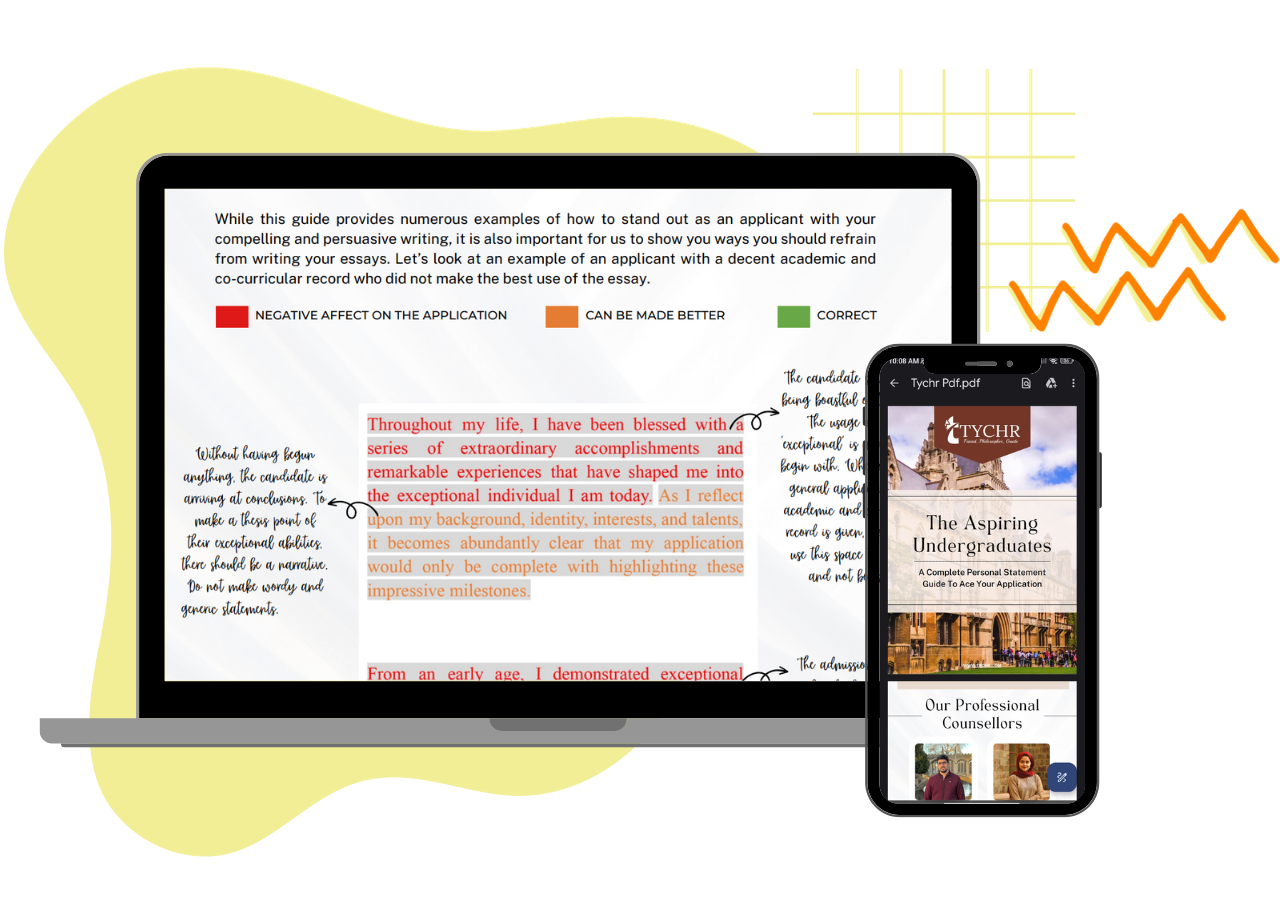
IB Business Management SL IA Ideas
This is a list IB Business Management SL IA ideas is a valuable resource for students to showcase their understanding of business concepts and theories. The IA is a research project that accounts for a significant portion of the grade, and students can choose from a wide range of topics and IA questions , such as globalisation, ethics, and technological advancements. Additionally, students can find high-scoring IB Business and Management Internal Assessment examples to improve their own work.
1.) What marketing strategies should Burger King use to expand their reach in the European market?
2.) how can wynn resorts ltd. reduce employee turnover in their call center, 3.) what steps can party city take to improve their supply chain efficiency, 4.) what pricing strategy should yves saint-laurent use to increase market share in the luxury goods sector, 5.) how can malabar gold & diamonds improve their customer service to increase customer loyalty, 6.) what steps can maruti suzuki take to reduce their carbon footprint, 7.) how can tcs improve their team collaboration and communication, 8.) what marketing strategies should raymond use to target the gen z demographic.
What marketing strategies should Raymond use to target the Gen Z demographic?
Don't forget to check our Forum
9.) how can costco improve their online sales and customer experience.
How can Costco improve their online sales and customer experience?
10.) To what extent does employee engagement affect organizational performance in Cognizant?
To what extent does employee engagement affect organizational performance in Cognizant?
11.) How can Kovai Pazhamudir Nilayam improve their procurement process and reduce costs?
How can Kovai Pazhamudir Nilayam improve their procurement process and reduce costs?
12.) What factors contribute to customer loyalty in Popeyes and how can they be improved?
What factors contribute to customer loyalty in Popeyes and how can they be improved?
13.) How can Himalaya diversify their product offerings and enter new markets?
How can Himalaya diversify their product offerings and enter new markets?
14.) How can Zomato effectively manage their international human resources?
How can Zomato effectively manage their international human resources?
15.) What impact does corporate social responsibility have on the financial performance of Bajaj Finance?
What impact does corporate social responsibility have on the financial performance of Bajaj Finance?
Our Expert Tutors!

Barbara Centis
Cat 1 – ESS and Cat 2 – Biology. Chief of the IB program. Mentored 320+ students across various curricula.

Dr Rashmi Kapoor
IBDP Cat 1 – Biology. Specializes in IBDP and A Levels Biology. 10+ years in Medicine with seasoned professionals.

Jacqueline Francis
IBDP Cat 1 – Business Management, IBDP Cat 1 – TOK. Taught over 130+ students across 4+ countries.

Dr. Nikita Bhan
IBDP Cat 1 & 2 November 2019. Specializes in Global Politics. Many students scored 7s; mentors 200+ students in assessments.

Shreya Narula
IBDP Cat 2 – English, IBDP Cat 2 – TOK. Qualifications as IB Examiner & Supervisor. Taught over 120+ students.

Sreevidya KG
IBDP Cat 1 – Chemistry, IBDP Cat 3 – IA Chemistry, IBDP Cat 1 – TOK. Helped 2 out of 3 students achieve a 7 in IB Chemistry.
Our Student'S Results
Score 40+ in IB Exam like they did
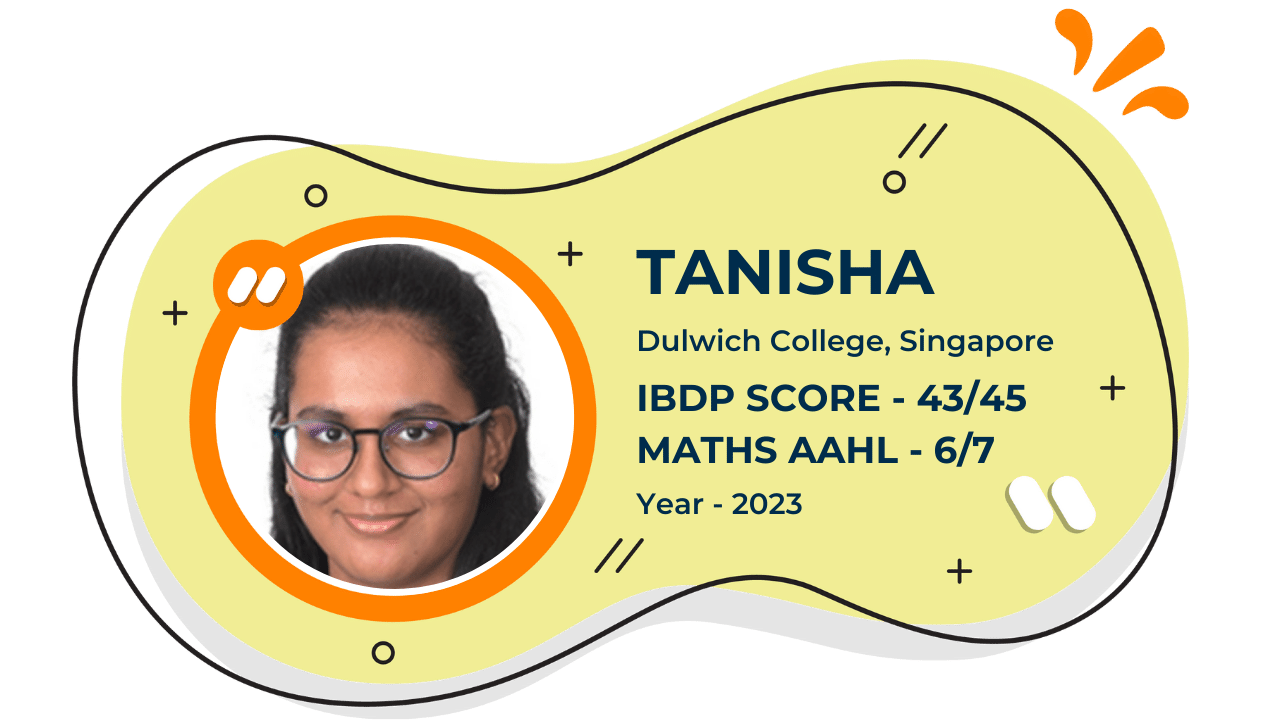
What our Students Have to say
A few words about us from our students…

IB Tutoring Recent Blogs
Give our blog a read for anything you need
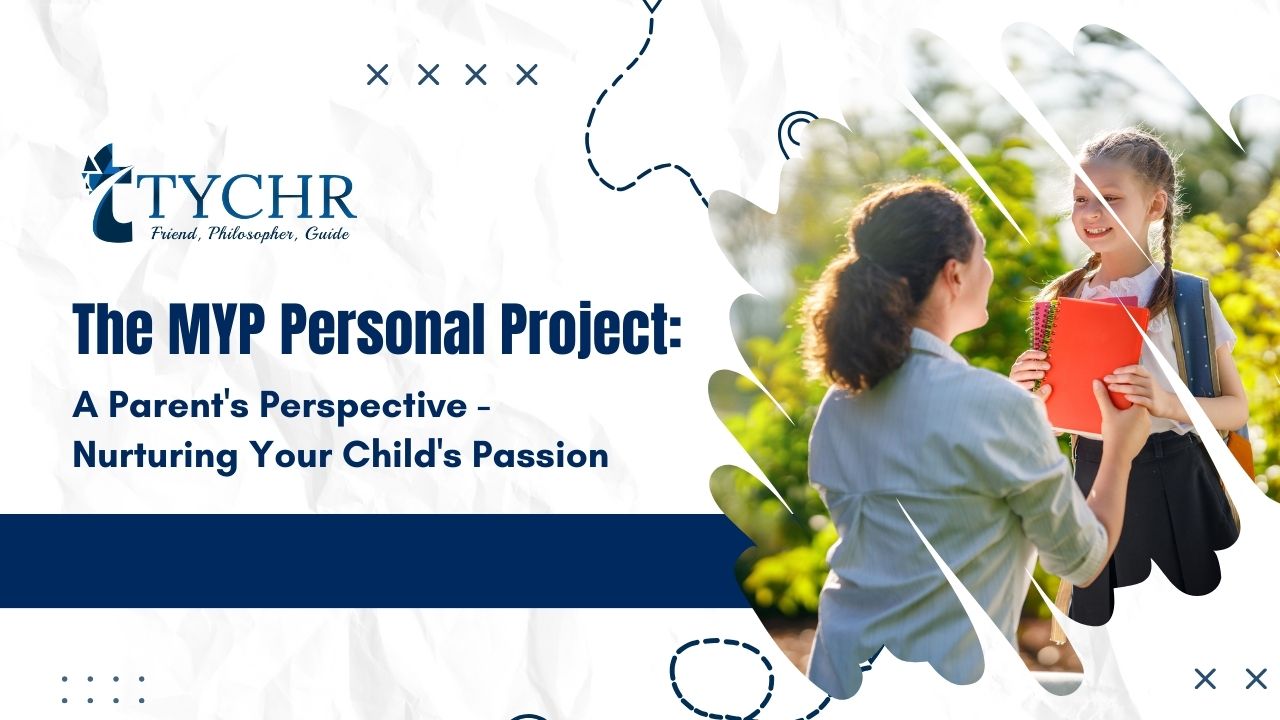
The MYP Personal Project: A Parent’s Perspective – Nurturing Your Child’s Passion

A SMOOTH PROGRESSION FROM IBMYP-1 TO IBMYP-5

Smooth Transition to IB-MYP: 10 Tips for Students and Parents

The Importance of Community Service in the IB Middle Years Programme (MYP): Nurturing Responsible Global Citizens

CAMBRIDGE VS IB-MYP
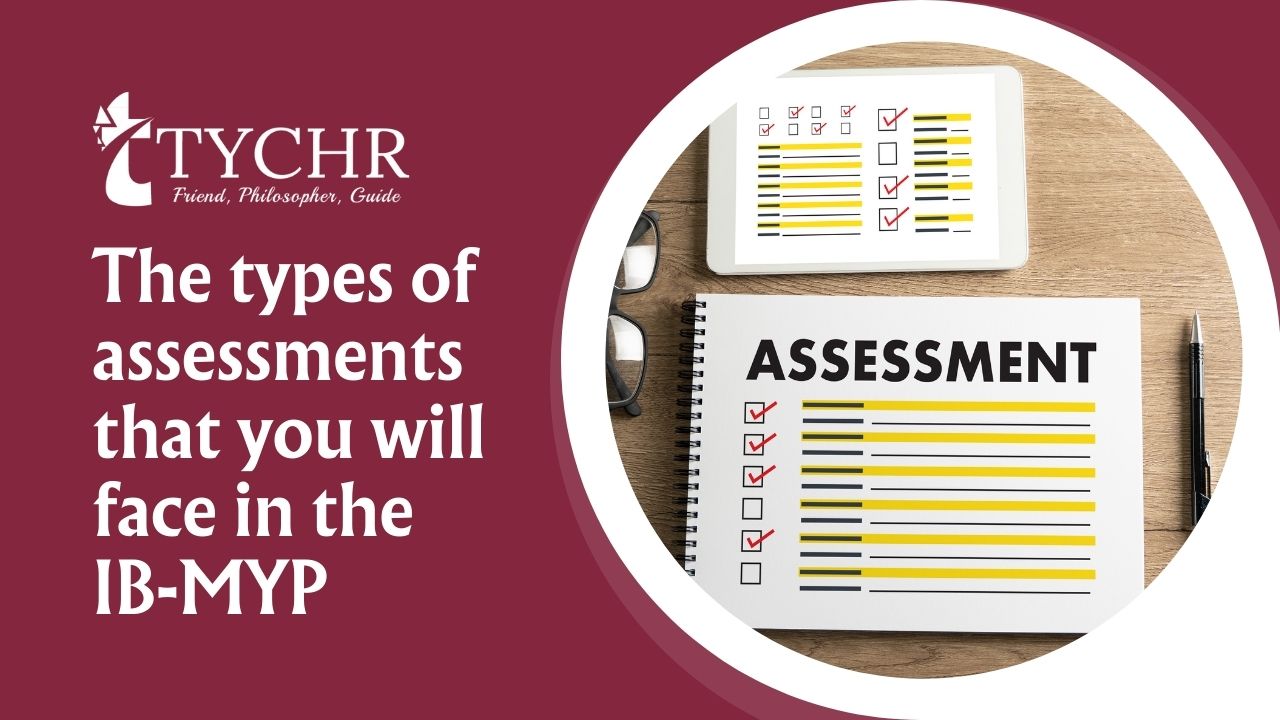
The types of assessments that you will face in the IB-MYP

IBMYP IN INDIA: Is it the right choice for you

Nurturing Effective Communication in the MYP: A Guide for Parents and Students
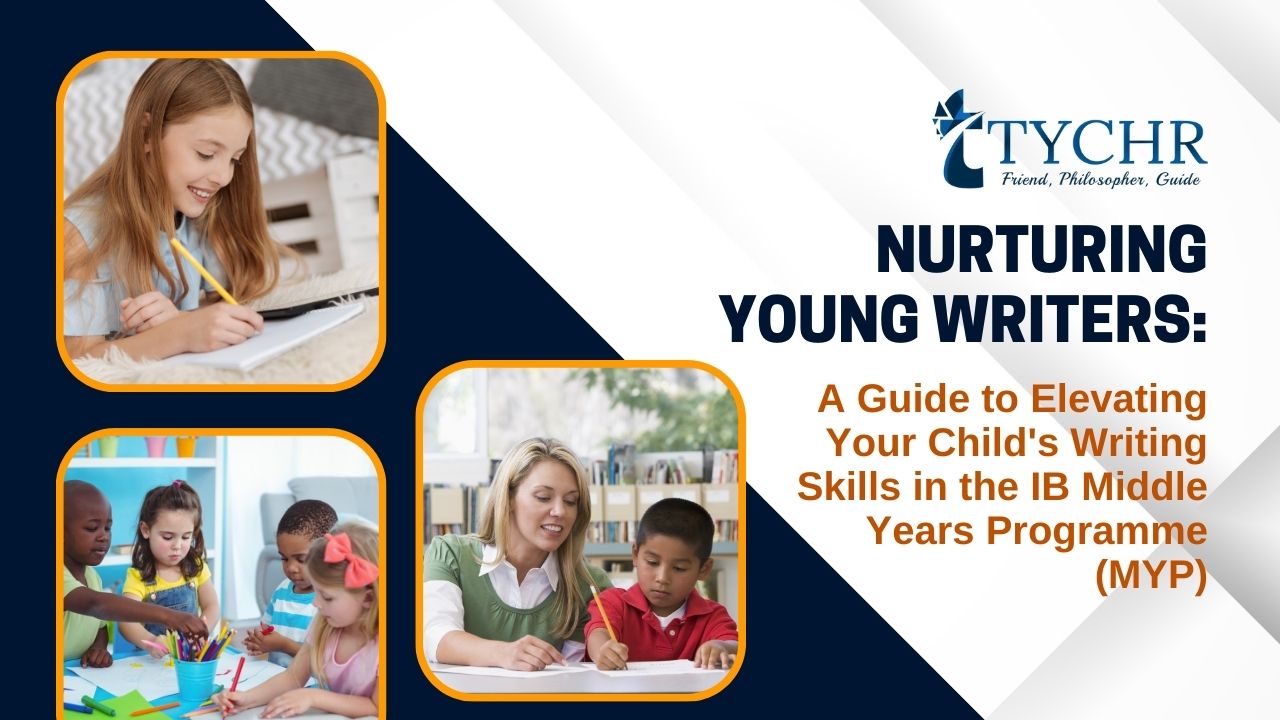
Nurturing Young Writers: A Guide to Elevating Your Child’s Writing Skills in the IB Middle Years Programme (MYP)

Guiding Your MYP Student’s Future: A Parent’s Conversational Toolkit
Get access to our free ib resources.

ANNOUNCEMENT
Download our Successful College Application Guide developed by counselors from the University of Cambridge for institutions like Oxbridge alongside other Ivy Leagues . To join our college counseling program, call at +918825012255
We are hiring a Business Development Associate and Content Writer and Social Media Strategist at our organisation TYCHR to take over the responsibility of conducting workshops and excelling in new sales territory. View More
IBDP Business Management
Website by Paul Hoang
Updated 28 May 2024
InThinking Subject Sites
Subscription websites for IB teachers & their classes
Find out more
- thinkib.net
- IBDP Biology
- IBDP Chemistry
- IBDP Economics
- IBDP English A Literature
- IBDP English A: Language & Literature
- IBDP English B
- IBDP Environmental Systems & Societies
- IBDP French B
- IBDP Geography
- IBDP German A: Language & Literature
- IBDP History
- IBDP Maths: Analysis & Approaches
- IBDP Maths: Applications & Interpretation
- IBDP Physics
- IBDP Psychology
- IBDP Spanish A
- IBDP Spanish Ab Initio
- IBDP Spanish B
- IBDP Visual Arts
- IBMYP English Language & Literature
- IBMYP Resources
- IBMYP Spanish Language Acquisition
- IB Career-related Programme
- IB School Leadership
Disclaimer : InThinking subject sites are neither endorsed by nor connected with the International Baccalaureate Organisation.
InThinking Subject Sites for IB Teachers and their Classes
Supporting ib educators.
- Comprehensive help & advice on teaching the IB diploma.
- Written by experts with vast subject knowledge.
- Innovative ideas on ATL & pedagogy.
- Detailed guidance on all aspects of assessment.
Developing great materials
- More than 14 million words across 24 sites.
- Masses of ready-to-go resources for the classroom.
- Dynamic links to current affairs & real world issues.
- Updates every week 52 weeks a year.
Integrating student access
- Give your students direct access to relevant site pages.
- Single student login for all of your school’s subscriptions.
- Create reading, writing, discussion, and quiz tasks.
- Monitor student progress & collate in online gradebook.
Meeting schools' needs
- Global reach with more than 200,000 users worldwide.
- Use our materials to create compelling unit plans.
- Save time & effort which you can reinvest elsewhere.
- Consistently good feedback from subscribers.
For information about pricing, click here
Download brochure
See what users are saying about our Subject Sites:
Find out more about our Student Access feature:
- SL IA - 20 Sample Titles
- Old course (N23)
Getting the research question is vital to getting a good grade based on the assessment criteria. Students need to choose an issue (research question) that:engages their interestis realistic in terms of access to secondary resourcesis well focusedmeets the criteria for IB assessmentThe research question should enable students to show evidence of critical and reflective thinking.
To access the entire contents of this site, you need to log in or subscribe to it.
Alternatively, you can request a one month free trial .

Other theories, concepts and tools that can be highly relevant to the Standard Level IA include:
• Ansoff's matrix
• Boston matrix - product portfolio analysis
• Economies of scale
• Investment appraisal - payback period
• Marketing strategies
• Outsourcing
• Position/perception maps
• Ratio analysis - profitability and liquidity.
Relates to Criterion B: Choice and application of tools, techniques and theories - 5 marks.
See Activity A - Analysis Planning below.

3. Gather resources.
You will need to include three to five secondary sources from which the majority of the information for the IA has been obtained. Ensure that each of your supporting documents covers one of the analytic tools, concepts and theories you will use to answer the research question.
ADD GOOD PRIMARY DATA SEE word doc
Choose a large company. A large company is going to have plenty of useful information, research and analysis that have been conducted by their own departments, as well as other researchers, analysts and journalists.
The selection of the documents is very important. It is expected that the IA’s will present contrasting ideas and views and be prepared by different authors and publications. The selection of five documents, for instance, produced by a single company would provide no balance or objectivity.
Secondary documents must be current (within two years) and could include some of the following:
• Market research surveys
• Articles from the local, national or international press
• Financial reports
• Business accounts
• Company annual reports
• Mission statements
• Web based reports and surveys
• Extracts from company websites or printed materials
• Government and other statistics
• Academic publications
• Audio (e.g., podcasts) or video (e.g., documentaries, news items, interviews). Warning! These need to be transcribed.
Relates to Criterion A: Supporting Documents - 5 marks.
Refer to the Guide to Writing the SL IA for more details.

4. Document your findings.
The choice of analytic tools MUST be able to be clearly related BOTH back to the research question AND forward to the answer of your research question. If they cannot do this then don't use that tool, you will lose marks.
You must justify the use of your chosen analytic tools or business concepts ie. How are you going to use them to answer your research question.
You must comment on your findings from your chosen analytic tools or business concepts in a way that directly relates to your research question answer.
Relates to Criterion C: Choice and analysis of data and integration of ideas - 5 marks.
Criterion F: Structure - 2 marks.
See Activity B - Linkage between research questions and analysis below.

5. Summarise the main findings for each analytic tool used.
The way to know you have an analysis that covers all three ESSENTIAL requirements for each analytic tool, concept or business theory, is to complete a table like the one set out below.
The three essential requirements for each analytic tool, concept or business theory are:
i. Justify the use of each analytic tool by linking it to your research question.
ii. Perform each analysis correctly.
iii. Comment on your findings for each analytic tool in a way that relates directly to the answer of your research question.
Interrelates to Criterion D: Conclusions - 3 marks.
Criterion E: Evaluation - 4 marks.
Criterion G: Presentation - 2 marks.
- Guide to Writing the SL IA
ACTIVITY A - Analysis Planning
Activity A: Construct a table like the one below to show which analytic tools, concepts and business theories you could use to answer your research question (RQ).
ACTIVITY B - Research Question
Weigh up the findings to answer the RQ - In light of the analyses, Apple should initiate its dividend and share buyback programme.
By the time you have integrated the information from your table into your main findings and results, analysis and discussion section, this will make for a good report, which would be more useful to your manager because you've shown the manager, step-by-step:
1. Why this analysis is necessary,
2. What the analysis shows, and
3. How that analysis relates to what the business should actually do.
You have therefore made your analysis much easier to understand and much more convincing.
Business Management IB
Bm study guide.

IA for Business Management
Internally assessed business management written commentary.
IA for Business SL is a written commentary that demonstrate the application of business management tools, techniques and theories to a specific business problem. Duration: 15 hoursclass time Weighting: 25%
Word Count: 1500. Marks: 25 marks 25%
IA Business Management Project Requirements
SL BM students are required to:
select a real business issue for a written commentary that relates to the SL syllabus.
refer directly to a single business organisation, but may consider industry-wide issues that impact on that organisation.
base their written commentary on secondary research, selected for its suitability, depth and breadth (primary research may be used as support).
provide a title for the commentary that, to give focus and direction, must be framed as a question.
produce a written commentary that does not exceed 1,500 words.
attach to the commentary three to five supporting documents from which the majority of the information for the commentary has been obtained.
fully reference all supporting documents and additional sources and include them in a bibliography.
HL BM students are required to:
design and undertake research that either addresses an issue facing a business or analyses a decision to be made by a business.
select a real business or a range of organisations and a real issue or decision under investigation.
base their research project on primary research they gather from the organisation investigated (secondary research may be used as support).
provide a title for the research project that, to give focus and direction, must be framed as a question.
produce a research proposal (of maximum 500 words), including an action plan, to be used as the primary planning document.
produce a written report that does not exceed 2,000 words.
write the report in a style and format of a useful working document for management.
Business Management Assessment Criteria for Internal Assessment
Internal assessment sl bm.
produce a written report that does not exceed 2,000 words
Criterion A: Supporting documents This criterion assesses the extent to which the student selects three to five relevant supporting documents that address the issue or problem selected for commentary in appropriate depth and breadth. The criterion also assesses whether the student’s choice and presentation of the supporting documents meets formal requirements.
Criterion B: Choice and application of tools, techniques and theories This criterion assesses the extent to which the student chooses business management tools, techniques and theories that are relevant to the issue or problem and applies these so that a greater insight into the situation of the organization ensues. For top marks be sure to include an appropriate selection of business management tools, techniques and theories.
Criterion C: Choice and analysis of data and integration of ideas This criterion assesses the extent to which the student uses data from the supporting documents effectively in order to understand and explain the issue or problem and is able to integrate ideas coherently. For top marks be sure to include an appropriate selection of data from the supporting documents with skilful analysis and a coherent integration of ideas.
Criterion D: Conclusions This criterion assesses the extent to which the student is able to draw relevant conclusions based on the analysis of the supporting documents and answer the commentary question. Conclusions must be consistent with the evidence presented and explicitly answer the commentary question.
Criterion E: Evaluation This criterion assesses the extent to which the student evaluates his or her arguments and makes judgments that are well substantiated. Be sure to provide thorough evidence of evaluation, and judgments that are well substantiated.
Criterion F: Structure This criterion assesses the extent to which the student organizes his or her ideas into a structured commentary with an argument that is easy to follow.
Criterion G: Presentation This criterion assesses the extent to which the student presents the written commentary well. This involves a title page, an accurate table of contents, appropriate headings and sub-headings, consistent referencing, a complete bibliography and numbered pages. All of the above elements of a well-presented commentary must be included.
Internal assessment HL BM
The HL business management research project is assessed against nine criteria that are related to the assessment objectives for the business management course. When the work to be assessed has been read, the descriptors for each criterion should be studied until a descriptor is reached that most appropriately describes the achievement level.
Criterion A: Research proposal This criterion assesses the extent to which the student presents a research proposal that gives an effective direction for the project, with all the required elements. The research proposal with all the required elements needs to be appropriate, detailed, clear and focused.
Criterion B: Sources and data This criterion assesses the extent to which the student selects primary sources and collects data which address an issue or a decision to be made by an organization or a range of organizations in appropriate depth and breadth. Be sure that the primary sources selected and the data collected are appropriate, varied and sufficient.
Criterion C: Use of tools, techniques and theories This criterion assesses the extent to which the student understands and applies relevant business management tools, techniques and theories so that a greater insight into the situation of the organization ensues. You must present a good understanding of relevant business management tools, techniques and theories.
Criterion D: Analysis and evaluation This criterion assesses the extent to which the student uses his or her results and findings effectively in order to explain the issue or decision to be made and is able to integrate his or her ideas coherently. This criterion also assesses the extent to which the student evaluates his or her arguments and makes judgments that are well substantiated.
Criterion E: Conclusions This criterion assesses the extent to which the student is able to draw relevant conclusions based on the analysis of the report. Conclusions are substantiated and consistent with the evidence presented in the main body of the report.
Criterion F: Recommendations This criterion assesses the extent to which the student is able to make substantiated recommendations that are consistent with the conclusions made and answer the research question. Your recommendations must be substantiated and consistent with the conclusions, and answer the research question.
Criterion G: Structure This criterion assesses the extent to which the student organizes his or her ideas into a structured report with an argument that is easy to follow.
IA Business Resources
Her is a list of guides and resources to help you write you Business Management IA:
IB Mastery:s Guide to Writing and IA https://goo.gl/Lrv3aw
IB Business Management Wesbite https://goo.gl/BQWYJU
Bracken's IB Business Website Guide and Resources and Examples of IAs https://goo.gl/32M6Gy
IB Business & Management Internal Assessment HL Guide Book https://goo.gl/YQbn9
Mr Keshab's IBDP IA Business Management Guide https://goo.gl/KBhrpN
IB Survival Business Management IA Guide and Example https://goo.gl/WHs8gb
Information about Business Managment https://goo.gl/V9wpwX


IB Biology IA: 60 Examples and Guidance
Charles Whitehouse
The International Baccalaureate (IB) program offers a variety of assessments for students, including Internal Assessments (IAs), which are pieces of coursework marked by students’ teachers. The Biology IA is an assessment designed to test students' understanding of the material they have learned in their biology course and their ability to conduct independent research.
What is the IA?
The IA consists of a laboratory report that students must complete during their IB biology course. For assessments before May 2025, the report should be 6 to 12 pages in length and should include a research question, a methodology section, data analysis, and a conclusion. From May 2025 , the report should be a maximum of 3,000 words.
What should the IA contain?
The research question for the internal assessment should be a testable question that is related to the biology curriculum. It's essential that the question is relevant to the biology curriculum, specific and clearly defined. The methodology section should explain how the research was conducted, including the materials and methods used. The methodology should be detailed and well-explained, and should include information on the materials and methods used, as well as any ethical considerations.
Data analysis is an important aspect of the IA. Students should present their data in a clear and organized manner, and should use appropriate statistical analysis to interpret their results. They should also make sure to include a discussion of the limitations of their study and the implications of their findings.
The conclusion should summarise the main findings of the study and should relate the results back to the research question. It should also include recommendations for further research.
In addition to the laboratory report, students must also complete a reflective statement. Online tutors recommend that this statement should be around 500 words long, and should reflect on the student’s learning during the internal assessment process. The reflective statement should include a description of the student’s personal learning process, including successes and challenges, as well as an evaluation of their performance on the internal assessment and the skills they have gained through the process.
Have a look at our comprehensive set resources for IB Biology developed by expert IB teachers and examiners!
- IB Biology 2024 Study Notes
- IB Biology 2025 Study Notes
- IB Biology 2024 Questions
- IB Biology 2025 Questions
What are some example research questions?
Here are examples with details of potential research questions, written by expert IB Biology tutors and teachers, that could inspire your Biology IA:
1 - Investigating the effect of different types of sugars on the rate of fermentation by yeast. To investigate the effect of different concentrations of a specific herbicide on the growth rate of a particular plant species, one could set up an experiment in which the plants are grown in soil with varying concentrations of the herbicide. An appropriate range of concentrations and a suitable plant species would need to be chosen, along with control variables such as light, temperature, and watering. The growth rate of the plants could be measured by tracking their height or mass over a set period of time. Comparing the growth rates of the different groups would determine the impact of the herbicide on the plant's growth.
2 - How does the pH of a solution affect the activity of an enzyme? To investigate the effect of pH on enzyme activity, one could set up an experiment in which the enzyme is exposed to solutions with varying pH levels. The enzyme's activity could be measured by monitoring the rate of a specific reaction catalyzed by the enzyme. Control variables such as temperature, substrate concentration, and enzyme concentration would need to be kept constant. By comparing the activity of the enzyme at different pH levels, the optimal pH range for the enzyme could be determined.
3 - Can the concentration of vitamin C in different types of fruit juice be determined using titration?
To determine the concentration of vitamin C in different types of fruit juice using titration, a standardized solution of a known concentration of potassium permanganate would be prepared. A sample of the fruit juice would be titrated with the potassium permanganate solution until the endpoint is reached, indicating that all the vitamin C has reacted with the potassium permanganate. The concentration of vitamin C in the fruit juice can then be calculated based on the volume and concentration of the potassium permanganate solution used in the titration. This process would need to be repeated for each type of fruit juice being tested.
4 - Investigating the effect of light intensity on the rate of photosynthesis in aquatic plants.
Set up an experiment in which aquatic plants are placed in containers with varying levels of light intensity. The light intensity could be controlled by adjusting the distance between the light source and the plants. The rate of photosynthesis could be measured by tracking the amount of oxygen produced by the plants over a set period of time. Comparing the rates of photosynthesis of the different groups would determine the impact of light intensity on the plant's photosynthetic activity. Control variables such as temperature, water quality, and plant species would need to be kept constant.
5 - How does the concentration of carbon dioxide affect the rate of photosynthesis in terrestrial plants?
Conduct an experiment in which plants are grown under different concentrations of carbon dioxide. The plants would need to be grown in a controlled environment with consistent light, temperature, and watering. The rate of photosynthesis could be measured by monitoring the oxygen production of the plants using a dissolved oxygen probe. The results could then be analyzed to determine how the concentration of carbon dioxide affects the rate of photosynthesis in terrestrial plants.
6 - Can the presence of glucose in urine be determined using Benedict's test?
Collect a urine sample from the individual being tested. Add Benedict's reagent to the sample and heat it in a water bath. If glucose is present in the urine, it will react with the Benedict's reagent and cause a color change. The intensity of the color change can be compared to a color chart to determine the concentration of glucose in the urine. This process would need to be repeated for each urine sample being tested.
7 - Investigating the effect of temperature on the respiration rate of germinating seeds.
Set up an experiment in which germinating seeds are exposed to different temperatures. The respiration rate of the seeds could be measured by monitoring the amount of oxygen consumed or carbon dioxide produced over a set period of time. The experiment would need to control for other variables such as the type of seed, the amount of water and nutrients provided, and the length of time the seeds have been germinating. Comparing the respiration rates of the different groups would determine the effect of temperature on the seeds' respiration rate.
8 - How does the concentration of salt in a solution affect the growth of bacteria?
Prepare a series of solutions with varying concentrations of salt, and inoculate each with a known amount of bacteria. The solutions would need to be incubated at a constant temperature for a set period of time, and the growth of the bacteria could be measured by counting the number of colonies or by using a spectrophotometer to measure the optical density of the solution. Comparing the growth rates of the bacteria in the different salt concentrations would determine the effect of salt on bacterial growth. Control variables such as pH, temperature, and nutrient availability would need to be kept constant.
9 - Can the concentration of nitrogen compounds in soil be determined using colorimetry?
Collect soil samples from different locations and extract the nitrogen compounds using a suitable method such as Kjeldahl digestion. The extracted compounds can then be analyzed using colorimetry, which involves adding a reagent that reacts with the nitrogen compounds and produces a color. The intensity of the color can be measured using a spectrophotometer, and the concentration of nitrogen compounds in the soil can be calculated based on the absorbance of the color. This process would need to be repeated for each soil sample being tested.
10 - Investigating the effect of different types of plant hormones on the growth of seedlings.
Set up an experiment in which seedlings are grown in different concentrations of plant hormones, with control variables such as light, temperature, and watering. The growth rate of the seedlings could be measured by tracking their height or mass over a set period of time. Comparing the growth rates of the different groups would determine the impact of the plant hormones on the seedlings' growth. The experiment could also include observations of other plant characteristics such as leaf size and color, root development, and overall health.
Get expert help with your IB Biology
The world's leading online IB Biology tutoring provider trusted by students, parents, and schools globally.
4.92 /5 based on 480 reviews
11 - How does the concentration of salt in water affect the hatching rate of brine shrimp?
Set up multiple containers with different concentrations of salt water and add brine shrimp eggs to each container. The containers should be kept at a consistent temperature and light level. After a set period of time, count the number of hatched brine shrimp in each container and calculate the hatching rate. Comparing the hatching rates of the different containers would determine the effect of salt concentration on the hatching rate of brine shrimp.
12 - Can the rate of mitosis be determined using microscopy techniques?
Collect a sample of cells undergoing mitosis and prepare them for microscopy. Using a microscope, observe the cells and record the time it takes for each cell to complete each stage of mitosis. The rate of mitosis can then be calculated by dividing the time taken for each stage by the total time taken for the entire process. This process would need to be repeated for multiple cells to ensure accuracy and reliability of the results.
13 - Investigating the effect of different types of antibiotics on the growth of bacteria.
Culture bacteria in petri dishes with different concentrations of antibiotics. The growth of the bacteria can be observed and measured over a set period of time. The concentration of antibiotic that inhibits the growth of the bacteria can be determined, and the effectiveness of different types of antibiotics can be compared. Control variables such as temperature, humidity, and nutrient availability would need to be kept constant to ensure accurate results.
14 - How does the concentration of oxygen affect the respiration rate of crickets?
Set up a series of chambers with different concentrations of oxygen, ranging from low to high. Place crickets in each chamber and monitor their respiration rate by measuring the amount of oxygen consumed and carbon dioxide produced over a set period of time. The results can be analyzed to determine the effect of oxygen concentration on the respiration rate of crickets. Control variables such as temperature and humidity would need to be kept constant throughout the experiment.
15 - Can the concentration of glucose in blood be determined using glucose oxidase and spectrophotometry?
A sample of blood would be mixed with glucose oxidase, which converts glucose to hydrogen peroxide. The amount of hydrogen peroxide produced is proportional to the amount of glucose in the sample. A spectrophotometer would then be used to measure the absorbance of the sample at a specific wavelength, which is also proportional to the amount of hydrogen peroxide present. The concentration of glucose in the blood sample can then be calculated based on the absorbance reading and a standard curve generated using known concentrations of glucose. This process would need to be repeated for each blood sample being tested.
16 - Investigating the effect of different types of pesticides on the growth of bean plants.
Set up an experiment in which bean plants are grown in soil treated with varying concentrations of different pesticides. An appropriate range of concentrations and a suitable plant species would need to be chosen, along with control variables such as light, temperature, and watering. The growth rate of the plants could be measured by tracking their height or mass over a set period of time. Comparing the growth rates of the different groups would determine the impact of the pesticides on the plant's growth. Additionally, the health of the plants could be assessed by examining their leaves for signs of damage or discoloration.
17 - How does the concentration of light affect the growth of algae?
Set up multiple containers with different concentrations of light, ranging from low to high. In each container, add a sample of algae and monitor their growth over a set period of time. The growth rate of the algae can be measured by tracking their biomass or chlorophyll content. Comparing the growth rates of the different groups would determine the impact of light concentration on the growth of algae. Control variables such as temperature, nutrient availability, and water quality would need to be maintained to ensure accurate results.
18 - Can the presence of starch in leaves be determined using iodine solution?
Obtain a sample of the leaf and grind it into a fine powder. Add a few drops of iodine solution to the powder and observe the color change. If the solution turns blue-black, it indicates the presence of starch in the leaf. This process would need to be repeated for multiple leaves from different plants to ensure accuracy and reliability of the results. Control variables such as the age of the leaf and the time of day the sample is taken should also be considered.
19 - Investigating the effect of different types of plant nutrients on the growth of tomatoes.
Set up an experiment in which tomato plants are grown in soil with varying concentrations of different plant nutrients, such as nitrogen, phosphorus, and potassium. Control variables such as light, temperature, and watering would need to be maintained. The growth rate of the plants could be measured by tracking their height or mass over a set period of time. Comparing the growth rates of the different groups would determine the impact of the plant nutrients on the plant's growth. Additionally, the nutrient content of the tomato plants could be analyzed to determine if there is a correlation between the nutrient concentration in the soil and the nutrient content in the plant.
20 - How does the concentration of carbon dioxide affect the growth of marine plants?
Conduct an experiment in which marine plants are grown in water with varying concentrations of carbon dioxide. The carbon dioxide concentration could be controlled by bubbling different amounts of carbon dioxide gas into the water. The growth rate of the plants could be measured by tracking their height, mass, or chlorophyll content over a set period of time. Comparing the growth rates of the different groups would determine the impact of carbon dioxide concentration on the plant's growth. Other variables such as light, temperature, and nutrient availability would need to be controlled to ensure that any differences in growth rate are due to the carbon dioxide concentration.
21 - Can the concentration of protein in an egg be determined using the Biuret method?
To determine the concentration of protein in an egg using the Biuret method, the egg would need to be homogenized and the protein extracted. A Biuret reagent would then be added to the protein extract, which would cause a color change if protein is present. The intensity of the color change would be proportional to the concentration of protein in the egg. A standard curve could be created using known concentrations of protein to determine the concentration of protein in the egg sample. This process would need to be repeated for each egg being tested.
22 - Investigating the effect of different types of plant hormones on the root growth of seedlings.
Set up an experiment in which seedlings are grown in soil with different concentrations of plant hormones. An appropriate range of concentrations and a suitable plant species would need to be chosen, along with control variables such as light, temperature, and watering. The root growth of the seedlings could be measured by tracking their length or mass over a set period of time. Comparing the root growth of the different groups would determine the impact of the plant hormones on the seedling's root growth.
23 - How does the concentration of oxygen affect the respiration rate of goldfish?
Set up multiple tanks with goldfish and varying levels of oxygen concentration. The respiration rate of the goldfish can be measured by tracking their oxygen consumption or carbon dioxide production. The experiment would need to be conducted over a set period of time with control variables such as temperature and feeding schedules. Comparing the respiration rates of the different groups would determine the effect of oxygen concentration on the goldfish's respiration rate.
24 - Can the concentration of a specific hormone in blood be determined using ELISA?
ELISA (enzyme-linked immunosorbent assay) involves coating a microplate with a specific antibody that binds to the hormone of interest. The sample of blood is then added to the plate, and any hormone present in the sample will bind to the antibody. A secondary antibody that is linked to an enzyme is then added, which will bind to the hormone-antibody complex. The enzyme will then catalyze a reaction that produces a detectable signal, such as a color change. The intensity of the signal is proportional to the amount of hormone present in the sample, allowing for the concentration of the hormone to be determined. A standard curve can be created using known concentrations of the hormone to accurately quantify the concentration in the sample.
25 - Investigating the effect of different types of pollutants on the growth of watercress.
Set up an experiment in which watercress plants are grown in water contaminated with different types and concentrations of pollutants. The growth rate of the plants could be measured by tracking their height or mass over a set period of time. Comparing the growth rates of the different groups would determine the impact of the pollutants on the plant's growth. Control variables such as light, temperature, and watering would need to be kept constant to ensure accurate results. The types and concentrations of pollutants used in the experiment would need to be carefully chosen based on their potential impact on watercress growth and their relevance to real-world pollution scenarios.
26 - How does the concentration of light affect the rate of respiration in germinating seeds?
Set up a series of experiments in which germinating seeds are exposed to different intensities of light. The rate of respiration could be measured by tracking the amount of oxygen consumed or carbon dioxide produced by the seeds over a set period of time. The experiment would need to control for other variables such as temperature and humidity. Comparing the rates of respiration for the different light intensities would determine the impact of light concentration on the rate of respiration in germinating seeds.
27 - Can the concentration of nitrates in water be determined using colorimetry?
Prepare a series of standard solutions of known concentrations of nitrates. A sample of the water would be mixed with a reagent that reacts with nitrates to produce a colored product. The intensity of the color would be measured using a colorimeter, and the concentration of nitrates in the water can be calculated based on the intensity of the color and the concentration of the standard solutions. This process would need to be repeated for each water sample being tested.
28 - Investigating the effect of different types of disinfectants on the growth of bacteria.
Prepare a culture of bacteria and divide it into multiple groups. Each group would be exposed to a different type of disinfectant, while control groups would not be exposed to any disinfectant. The growth rate of the bacteria in each group would be measured over a set period of time, either by counting the number of colonies or by measuring the turbidity of the culture. Comparing the growth rates of the different groups would determine the effectiveness of each disinfectant on inhibiting bacterial growth.
29 - How does the concentration of salt in water affect the growth of duckweed?
Set up multiple containers of water with varying concentrations of salt. Add duckweed to each container and monitor their growth over a set period of time. The growth rate of the duckweed can be measured by tracking their surface area or biomass. Comparing the growth rates of the different groups would determine the impact of salt concentration on the growth of duckweed. Control variables such as light, temperature, and nutrients should be kept constant across all containers.
30 - Can the concentration of ethanol in different types of alcoholic beverages be determined using gas chromatography?
Use gas chromatography to separate the components of the alcoholic beverage sample. The ethanol would be detected and quantified using a detector such as a flame ionization detector. The concentration of ethanol in each sample can then be calculated based on the peak area or height of the ethanol peak in the chromatogram. This process would need to be repeated for each type of alcoholic beverage being tested.
31 - Investigating the effects of different types of exercise on heart rate and blood pressure.
Recruit a group of participants and randomly assign them to different exercise groups (e.g. running, cycling, weightlifting). Measure their heart rate and blood pressure before and after the exercise session. Repeat this process for each exercise group. Analyze the data to determine if there are any significant differences in the effects of the different types of exercise on heart rate and blood pressure. Control variables such as age, gender, and fitness level should be taken into account.
32 - How does the level of noise pollution affect the behavior and communication of animals?
Conduct a field study in which the behavior and communication of animals in areas with varying levels of noise pollution are observed and recorded. Control variables such as time of day, weather conditions, and animal species would need to be taken into account. The observations could include changes in vocalizations, movement patterns, and social interactions. Comparing the behavior and communication of animals in areas with different levels of noise pollution would determine the impact of noise on their behavior. Statistical analysis could be used to establish correlations between noise levels and changes in animal behavior.
33 - Investigating the effects of different types of fertilizers on plant growth and nutrient uptake.
Set up an experiment in which identical plants are grown in soil with different types of fertilizers. The growth rate of the plants could be measured by tracking their height or mass over a set period of time. Nutrient uptake could be measured by analyzing the nutrient content of the plants at the end of the experiment. Comparing the growth rates and nutrient uptake of the different groups would determine the impact of the fertilizers on plant growth and nutrient uptake. Control variables such as light, temperature, and watering would need to be kept constant.
34 - How does exposure to light pollution affect the migration and behavior of nocturnal animals?
Conduct a field study in which nocturnal animals are observed in areas with varying levels of light pollution. The behavior and migration patterns of the animals could be tracked using GPS or radio telemetry. Data on the animals' activity levels, movement patterns, and habitat use could be collected and compared between areas with different levels of light pollution. This would allow for an assessment of the impact of light pollution on nocturnal animals and their ecosystems.
35 - Investigating the effects of different types of water pollution on aquatic ecosystems and organisms.
Set up multiple tanks or containers with different types and levels of water pollution, such as oil spills, chemical runoff, or excess nutrients. Populate each tank with a variety of aquatic organisms, such as fish, algae, and invertebrates. Monitor the health and behavior of the organisms over a set period of time, noting any changes in growth, reproduction, or mortality rates. Comparing the results from each tank would allow for an assessment of the impact of different types of water pollution on aquatic ecosystems and organisms.
36 - How does exposure to electromagnetic radiation affect the growth and development of plants?
Set up an experiment in which plants are exposed to different levels of electromagnetic radiation, such as UV light or radio waves. The plants would need to be grown in a controlled environment with consistent light, temperature, and watering. The growth rate and development of the plants could be measured by tracking their height, leaf size, and overall health over a set period of time. Comparing the growth and development of the plants exposed to different levels of electromagnetic radiation would determine the impact of the radiation on the plants. Control groups of plants not exposed to radiation would also need to be included for comparison.
37 - Investigating the effects of different types of air pollution on respiratory function and lung health.
Recruit a sample of participants who are exposed to different types of air pollution, such as those who live near busy roads or industrial areas. Conduct lung function tests, such as spirometry, on each participant to establish a baseline measurement of their respiratory health. Repeat the tests after a set period of time to determine any changes in lung function. Comparing the results of participants exposed to different types of air pollution would determine the impact of each type on respiratory function and lung health. Other factors, such as age and smoking status, would need to be controlled for in the analysis.
38 - How does the level of acidity affect the growth and survival of aquatic organisms?
Conduct experiments in which aquatic organisms are exposed to different levels of acidity. The organisms could be placed in tanks with varying pH levels, and their survival and growth rates could be monitored over time. Control variables such as temperature, light, and food availability would need to be kept constant. Comparing the survival and growth rates of the different groups would determine the impact of acidity on the organisms. Additionally, other factors such as changes in behavior or reproduction could also be observed and analyzed.
39 - Investigating the effects of different types of food additives on human health and metabolism.
Conduct a literature review to identify the potential health effects of different food additives. Design a study in which participants consume a controlled diet with varying levels of the food additives being tested. Blood and urine samples could be collected at regular intervals to measure changes in metabolism and biomarkers of health. Statistical analysis would be used to determine if there are significant differences in health outcomes between the different groups.
40 - How does the level of UV radiation affect the growth and survival of plants?
Set up an experiment in which plants are grown under different levels of UV radiation. This could be achieved by using UV lamps of varying intensities or by placing the plants at different distances from a natural source of UV radiation, such as the sun. The growth rate, survival rate, and other relevant factors such as leaf size and chlorophyll content could be measured and compared across the different groups. This would help determine the impact of UV radiation on plant growth and survival. Control variables such as temperature, humidity, and watering would need to be carefully monitored and controlled to ensure accurate results.
41 - Investigating the effects of different types of drugs on human physiology and behavior.
Conduct a double-blind, randomized controlled trial with a group of participants who are given different types of drugs. The physiological and behavioral effects of the drugs would be measured through various tests and assessments, such as blood pressure, heart rate, cognitive function, and mood. The results would be analyzed to determine the impact of each drug on the participants' physiology and behavior, and any potential side effects or risks associated with each drug would be identified.
42 - How does the level of carbon dioxide affect the growth and development of plants?
Conduct an experiment in which plants are grown in controlled environments with varying levels of carbon dioxide. The growth rate, height, and biomass of the plants can be measured over a set period of time. The results can be compared to determine the impact of different levels of carbon dioxide on plant growth and development. Other variables such as light, temperature, and watering would need to be controlled to ensure that the results are accurate and reliable.
43 - Investigating the effects of different types of pesticides on non-target organisms and ecosystems.
Conduct a series of experiments in which different non-target organisms are exposed to varying concentrations of the pesticide. The organisms could be chosen based on their ecological importance, such as pollinators or soil microorganisms. The effects of the pesticide on the organisms could be measured by tracking their survival rates, reproductive success, or behavior. Additionally, the impact of the pesticide on the broader ecosystem could be assessed by monitoring changes in the abundance and diversity of other species in the area. Comparing the results of these experiments would provide insight into the potential ecological risks associated with the use of the pesticide.
44 - How does the level of atmospheric pollutants affect the growth and development of plants?
Set up an experiment in which plants are grown in controlled environments with varying levels of atmospheric pollutants, such as nitrogen dioxide or ozone. The growth rate, leaf area, and chlorophyll content of the plants could be measured over a set period of time. Comparing the growth rates and health of the plants exposed to different levels of pollutants would determine the impact of atmospheric pollutants on plant growth and development. Control variables such as light, temperature, and watering would need to be kept constant to ensure accurate results.
45 - Investigating the effects of different types of microorganisms on the digestive system and gut microbiome.
Conduct a study in which different groups of animals are exposed to different types of microorganisms, either through their diet or through direct exposure. The effects on their digestive system and gut microbiome could be measured through various methods such as analyzing fecal samples, measuring changes in gut pH, or monitoring the presence of certain bacteria. Comparing the results from the different groups would determine the impact of the microorganisms on the animals' digestive system and gut microbiome.
46 - How does the level of humidity affect the growth and survival of insects?
Conduct an experiment in which insects are exposed to different levels of humidity in a controlled environment. The survival rate and growth rate of the insects could be measured over a set period of time. The experiment would need to control for other variables such as temperature, food availability, and lighting. Comparing the survival and growth rates of the insects in different humidity levels would determine the impact of humidity on their growth and survival.
47 - Investigating the effects of different types of radiation on the genetic material and DNA replication.
Cultivate a sample of cells in a controlled environment and expose them to different types of radiation, such as gamma rays or UV light. The cells would then be monitored for changes in their genetic material, such as mutations or damage to DNA replication. The results could be compared to a control group that was not exposed to radiation to determine the effects of each type of radiation on the cells. Additional experiments could be conducted to investigate the long-term effects of radiation exposure on the cells.
48 - How does the level of soil salinity affect the growth and survival of plants?
Set up an experiment in which plants are grown in soil with varying levels of salinity. An appropriate range of salinity levels and a suitable plant species would need to be chosen, along with control variables such as light, temperature, and watering. The growth rate and survival rate of the plants could be measured by tracking their height, mass, and number of leaves over a set period of time. Comparing the growth and survival rates of the different groups would determine the impact of soil salinity on the plant's growth and survival. Additionally, the concentration of ions in the soil could be measured to determine the relationship between soil salinity and plant growth.
49 - Investigating the effects of different types of antibiotics on bacterial growth and antibiotic resistance.
Set up a series of petri dishes with agar and bacterial cultures. Each dish would contain a different antibiotic, with varying concentrations. The dishes would be incubated for a set period of time, and the growth of the bacteria would be measured. The results would show which antibiotics were most effective at inhibiting bacterial growth, and whether any resistance had developed. Control variables such as temperature, humidity, and the type of bacteria used would need to be carefully controlled to ensure accurate results.
50 - How does the level of soil pH affect the growth and survival of plants?
Conduct an experiment in which plants are grown in soil with varying pH levels. An appropriate range of pH levels and a suitable plant species would need to be chosen, along with control variables such as light, temperature, and watering. The growth rate of the plants could be measured by tracking their height or mass over a set period of time. Comparing the growth rates of the different groups would determine the impact of soil pH on the plant's growth and survival. Other factors such as nutrient availability and toxicity would also need to be considered and controlled for in the experiment.
51 - Investigating the effects of different types of hormones on animal behavior and physiology.
Conduct experiments with different groups of animals, each exposed to a different hormone. The behavior and physiology of the animals would be monitored and recorded over a set period of time. Control variables such as diet, environment, and age would need to be maintained across all groups. Comparing the results of the different groups would determine the effects of each hormone on the animals' behavior and physiology. Statistical analysis could be used to determine the significance of the results.
52 - How does the level of water availability affect the growth and survival of plants?
Conduct an experiment in which plants are grown in different levels of water availability, ranging from drought conditions to optimal watering. The growth rate, survival rate, and overall health of the plants would be monitored over a set period of time. The data collected would be used to determine the impact of water availability on plant growth and survival. Control variables such as light, temperature, and soil type would need to be kept constant to ensure accurate results.
53 - Investigating the effects of different types of plant extracts on bacterial growth and antibiotic resistance.
Prepare bacterial cultures in petri dishes with different concentrations of the plant extracts. The growth of the bacteria can be observed over a set period of time, and the effectiveness of the plant extracts in inhibiting bacterial growth and antibiotic resistance can be determined by comparing the growth rates of the different groups. Control variables such as temperature and nutrient availability would need to be kept constant to ensure accurate results.
54 - How does the level of nutrients affect the growth and development of microorganisms?
Conduct experiments in which microorganisms are grown in nutrient-rich and nutrient-poor environments. The growth rate and development of the microorganisms could be measured by tracking their population size and observing their morphology under a microscope. Comparing the growth rates and morphology of the microorganisms in the different environments would determine the impact of nutrient levels on their growth and development. Control variables such as temperature, pH, and oxygen levels would need to be kept constant.
55 - Investigating the effects of different types of pollution on the reproductive systems and fertility of animals.
Select a suitable animal species and expose them to different types of pollution, such as air pollution or water pollution. The reproductive systems and fertility of the animals could be monitored over a set period of time, and compared to a control group that was not exposed to pollution. The impact of the pollution on the animals' reproductive systems and fertility could be determined by analyzing factors such as the number of offspring produced, the health of the offspring, and any abnormalities or complications observed during pregnancy or birth.
56 - How does the level of light intensity affect the growth and development of microorganisms?
Set up multiple petri dishes with agar and different levels of light intensity, ranging from complete darkness to bright light. Inoculate each dish with the same strain of microorganisms and incubate them for a set period of time. The growth of the microorganisms can be measured by counting the number of colonies or by measuring the turbidity of the culture. Comparing the growth rates of the different groups would determine the impact of light intensity on the growth and development of the microorganisms. Control variables such as temperature, nutrient availability, and humidity would need to be maintained throughout the experiment.
57 - Investigating the effects of different types of food on the metabolism and energy balance of humans.
Conduct a randomized controlled trial in which participants are assigned to different groups and given different types of food to eat for a set period of time. The participants' energy intake, metabolism, and weight would be measured before and after the intervention to determine the impact of the different types of food on their energy balance. Other factors such as physical activity levels and sleep patterns would also need to be controlled for to ensure accurate results.
58 - How does the level of nutrients affect the growth and development of plants?
Conduct an experiment in which plants are grown in different nutrient solutions with varying levels of nitrogen, phosphorus, and potassium. The growth rate, height, and mass of the plants could be measured over a set period of time to determine the impact of the nutrient levels on their growth and development. Control variables such as light, temperature, and watering would need to be kept constant. The results could be analyzed to determine the optimal nutrient levels for plant growth and development.
59 - Investigating the effects of different types of hormones on plant growth and development.
Set up an experiment in which different groups of plants are treated with different types and concentrations of hormones. The growth rate, height, and mass of the plants could be measured over a set period of time. Control variables such as light, temperature, and watering would need to be kept constant. Comparing the growth rates of the different groups would determine the impact of the hormones on the plant's growth and development. Additional measurements such as leaf size, root length, and flower production could also be taken to further analyze the effects of the hormones.
60 - How does the level of water quality affect the growth and survival of aquatic organisms?
Set up multiple aquariums with varying levels of water quality, such as different levels of pollutants or pH. Introduce the same species of aquatic organism into each aquarium and monitor their growth and survival over a set period of time. The growth rate and survival rate of the organisms can be compared between the different aquariums to determine the impact of water quality on their growth and survival. Control variables such as temperature and feeding schedules should be kept consistent across all aquariums.
Remember to come up with your own original IA topic and check it with your teacher. It should be practical to conduct and relevant to the syllabus. Even A-Level Biology tutors say that this is a great opportunity to develop your personal interests, while advancing your knowledge of the Biology curriculum.
How can I prepare for the IA?
To prepare for the IA, students should ensure that they understand the material covered in their biology course and should practice writing lab reports. They should also seek feedback from their teachers on their writing skills and their understanding of the research process. IB tutors provide personalized guidance and can help students understand complex topics and achieve higher grades as well.
TutorChase's IB resources are perfect for students who want to get a 7 in their IB Biology exams and also prepare for the internal assessment. They are completely free, cover all topics in depth, also have IB Biology past papers and are structured by topic so you can easily keep track of your progress.
How is the IA graded?
The IA is worth 20% of the final grade for the IB biology course, whether you are studying at Higher or at Standard Level. It is graded by the student’s teacher, who is trained and certified by the International Baccalaureate organization. The report is then sent to a moderator, who will check that the report adheres to the IB guidelines and that the grade awarded is appropriate.
Online Biology tutors emphasise that it is important for students to be familiar with the assessment criteria for the biology internal assessment. These criteria are used to grade the laboratory report and reflective statement, and include aspects such as the quality of the research question, the methodology used, the data analysis, and the conclusion. Students should also make sure that their report is well-written and properly formatted, and that it includes all the required sections.
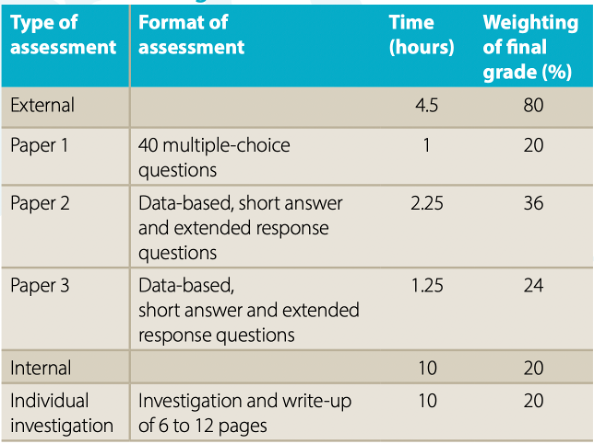
Source: IB Biology Subject Guide, pre-May 2025
In summary, the IA in the IB is an opportunity for students to demonstrate their understanding of the biology curriculum, as well as their ability to conduct independent research. It consists of a laboratory report and a reflective statement, and is worth 20% of the final grade for the course. To prepare for the assessment, students should ensure that they understand the material covered in their IB Biology.
Need help from an expert?
The world’s top online tutoring provider trusted by students, parents, and schools globally.
Study and Practice for Free
Trusted by 100,000+ Students Worldwide
Achieve Top Grades in your Exams with our Free Resources.
Practice Questions, Study Notes, and Past Exam Papers for all Subjects!
Need Expert Help?
If you’re looking for assistance with IB Biology, get in touch with the TutorChase team and we’ll be able to provide you with an expert IB Biology tutor . We’ll be there every step of the way!

Professional tutor and Cambridge University researcher

Written by: Charles Whitehouse
Charles scored 45/45 on the International Baccalaureate and has six years' experience tutoring IB and IGCSE students and advising them with their university applications. He studied a double integrated Masters at Magdalen College Oxford and has worked as a research scientist and strategy consultant.
Related Posts

What are the Hardest IB Subjects?

IB Theory of Knowledge: Knowledge Questions Explained

How to Choose Your IB Subjects

Hire a tutor
Please fill out the form and we'll find a tutor for you
- Select your country
- Afghanistan
- Åland Islands
- American Samoa
- Antigua and Barbuda
- Bosnia and Herzegovina
- Bouvet Island
- British Indian Ocean Territory
- Brunei Darussalam
- Burkina Faso
- Cayman Islands
- Central African Republic
- Christmas Island
- Cocos (Keeling) Islands
- Congo, The Democratic Republic of the
- Cook Islands
- Cote D'Ivoire
- Czech Republic
- Dominican Republic
- El Salvador
- Equatorial Guinea
- Falkland Islands (Malvinas)
- Faroe Islands
- French Guiana
- French Polynesia
- French Southern Territories
- Guinea-Bissau
- Heard Island and Mcdonald Islands
- Holy See (Vatican City State)
- Iran, Islamic Republic Of
- Isle of Man
- Korea, Democratic People'S Republic of
- Korea, Republic of
- Lao People'S Democratic Republic
- Libyan Arab Jamahiriya
- Liechtenstein
- Macedonia, The Former Yugoslav Republic of
- Marshall Islands
- Micronesia, Federated States of
- Moldova, Republic of
- Netherlands
- Netherlands Antilles
- New Caledonia
- New Zealand
- Norfolk Island
- Northern Mariana Islands
- Palestinian Territory, Occupied
- Papua New Guinea
- Philippines
- Puerto Rico
- Russian Federation
- Saint Helena
- Saint Kitts and Nevis
- Saint Lucia
- Saint Pierre and Miquelon
- Saint Vincent and the Grenadines
- Sao Tome and Principe
- Saudi Arabia
- Serbia and Montenegro
- Sierra Leone
- Solomon Islands
- South Africa
- South Georgia and the South Sandwich Islands
- Svalbard and Jan Mayen
- Switzerland
- Syrian Arab Republic
- Taiwan, Province of China
- Tanzania, United Republic of
- Timor-Leste
- Trinidad and Tobago
- Turkmenistan
- Turks and Caicos Islands
- United Arab Emirates
- United Kingdom
- United States
- United States Minor Outlying Islands
- Virgin Islands, British
- Virgin Islands, U.S.
- Wallis and Futuna
- Western Sahara

Still have questions? Let’s get in touch.

- AI " target="_blank" title="Share on Reddit">

Khan Academy and Microsoft partner to expand access to AI tools that personalize teaching and help make learning fun

10 more AI terms everyone should know

7 takeaways from a year of building generative AI responsibly and at scale

Equipped with AI and technology skills, women across Southeast Asia find new career opportunities

To keep fish and shrimp healthy, farmers in Indonesia now have a copilot to help
- SUGGESTED TOPICS
- The Magazine
- Newsletters
- Managing Yourself
- Managing Teams
- Work-life Balance
- The Big Idea
- Data & Visuals
- Reading Lists
- Case Selections
- HBR Learning
- Topic Feeds
- Account Settings
- Email Preferences
Why Employees Who Work Across Silos Get Burned Out
- Eric Quintane,
- Jung Won Lee,
- Camila Umaña Ruiz,
- Martin Kilduff

And how companies can better support these important cross-functional workers.
When employees collaborate across silos, there are numerous benefits for organizations. But the employees who do this critical work — also known as boundary spanners or network brokers — may end up overwhelmed, burned out, and can even develop abusive behavior toward their fellow employees. Research shows why this can happen, and suggests three key strategies companies can use to mitigate any negative effects: strategically integrating cross-silo collaboration into formal roles, providing adequate resources, and developing check-in mechanisms and opportunities to disengage.
In today’s fast-paced and complex business environment, fostering collaboration across organizational silos, whether between different teams, divisions, or regional offices, is no longer a luxury — it’s a necessity. It is key to improving performance, unlocking innovation, and speeding up coordination .
- Eric Quintane is an associate professor of organizational behavior at ESMT Berlin. He holds a PhD in management from the University of Melbourne in Australia. His research focuses on understanding the dynamics of interpersonal networks and their consequences for individuals (such as innovative performance or burnout).
- SL Sunny Lee is an Associate Professor of Organizational Behavior and the Deputy Director of Diversity and Inclusion at UCL School of Management. She has a PhD from London Business School. Her research focuses on identifying biases within human resources processes, such as recruitment and promotion, and the psychological implications of workplace behaviors.
- JL Jung Won Lee is an assistant professor of organizational behavior at ESSEC Business School. She has a PhD from UCL School of Management. Her research focuses on psychological antecedents and consequences of interpersonal networks.
- CR Camila Umaña Ruiz is a consultant and Assistant Professor in Organizational Behavior and HR at Pontificia Universidad Javeriana. She has a PhD from Universidad de los Andes. Her research focuses on interpersonal and organizational antecedents and consequences of job stress and burnout.
- Martin Kilduff is Professor and Director of Research at UCL School of Management. He has a PhD from Cornell University. His research focuses on interpersonal social networks in organizations.
Partner Center
- Skip to main content
- Skip to primary sidebar
- Skip to footer
- QuestionPro

- Solutions Industries Gaming Automotive Sports and events Education Government Travel & Hospitality Financial Services Healthcare Cannabis Technology Use Case NPS+ Communities Audience Contactless surveys Mobile LivePolls Member Experience GDPR Positive People Science 360 Feedback Surveys
- Resources Blog eBooks Survey Templates Case Studies Training Help center
Home Market Research
Cannabis Industry Business Intelligence: Impact on Research
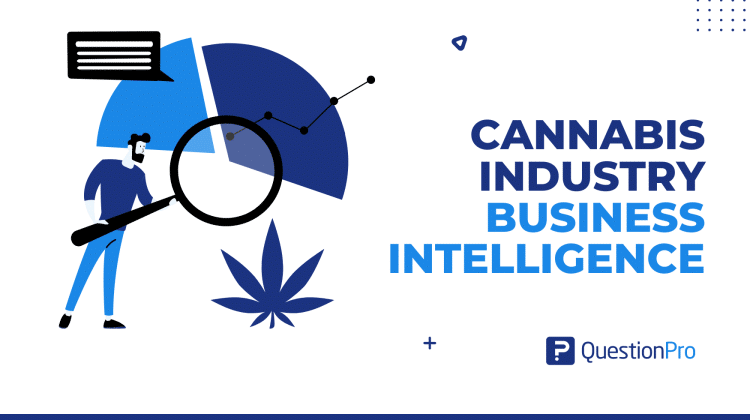
The cannabis industry has grown tremendously over the past decade, and with this growth comes the need for sophisticated business intelligence tools to drive research and insights.
As businesses in this sector aspire to gain a competitive edge, the role of cannabis industry business intelligence becomes crucial. Let’s analyze the impact of business intelligence on cannabis industry research, exploring various aspects, including AI, lucrative sectors, and the importance of data analytics.
What is Cannabis Industry Business Intelligence?
Cannabis Industry Business Intelligence (CIBI) uses data analytics, software tools, and strategies to gather, process, and analyze information relevant to the cannabis market. This intelligence helps businesses make informed decisions, optimize operations, understand market trends, and predict future developments. CIBI encompasses a range of activities, from tracking sales and customer preferences to monitoring regulatory changes and competitor strategies.
AI in the Cannabis Industry
On its part, Artificial Intelligence (AI) is revolutionizing the cannabis industry by automating processes, improving efficiency, and providing deeper insights into market trends.
AI in the cannabis industry uses machine learning algorithms and data analytics to optimize cultivation, enhance product quality, and streamline supply chain management. For instance, AI can predict crop yields, detect plant diseases early, and personalize marketing efforts based on consumer behavior patterns.
The Most Lucrative Sector of the Cannabis Industry
The cannabis industry comprises several sectors, each with its own potential for profitability. Currently, the most lucrative sectors include:
- Recreational Cannabis : The legalization of recreational cannabis in various regions has opened up significant revenue streams. This sector attracts a wide range of consumers and generates substantial sales.
- Medical Cannabis : With an increasing number of patients turning to cannabis for therapeutic purposes, the medical cannabis sector remains highly profitable. Products range from oils and tinctures to capsules and topicals.
- Cannabis Edibles and Beverages : This rapidly growing sector offers an array of products infused with cannabis, such as gummies, chocolates, and drinks. The convenience and discreet nature of these products make them popular among consumers.
- Cannabis Extracts and Concentrates : High-potency products like oils, waxes, and shatter are gaining traction, and due to their concentrated nature, they offer higher margins.
The Cannabis Industry Insights
It’s important to talk about what Headset is. We’re talking about a leading provider of data analytics software specifically designed for the cannabis industry. The platform offers real-time data and insights to help businesses make informed decisions. However, it’s important for some businesses to consider alternatives that better align with their needs.
Headset software covers various aspects of the cannabis market, including sales trends, product performance, and consumer behavior. For a business that covers more aspects, an alternative that focuses on insights might be a better option.
Data analytics plays a pivotal role in the cannabis industry, enabling businesses to:
- Track Sales and Market Trends : By analyzing sales data, companies can identify popular products, peak sales periods, and emerging market trends.
- Understand Consumer Preferences : Detailed consumer data helps businesses tailor their products and marketing strategies to meet the needs and preferences of their target audience.
- Optimize Operations : Data analytics can streamline operations by improving supply chain management, reducing waste, and enhancing production efficiency.
- Ensure Compliance : In an industry heavily regulated by laws and standards, data analytics helps businesses stay compliant by tracking regulatory changes and ensuring all processes meet legal requirements.
How to Identify Good Cannabis Industry Business Intelligence Tools
When selecting business intelligence tools for the cannabis industry, consider the following factors:
- Comprehensive Data Coverage : The tool should provide extensive data on various aspects of the cannabis market, including sales, consumer behavior, and regulatory changes.
- Real-Time Insights : Timely data is crucial for making informed decisions. Look for tools that offer real-time analytics and reporting.
- User-Friendly Interface : The tool should be easy to use, allowing team members to access and interpret data at all levels.
- Customization Options : Each business has unique needs. A good BI tool should offer customizable dashboards and reports.
- Integration Capabilities : The tool should seamlessly integrate with other software and platforms the business uses, such as CRM systems and accounting software.
How QuestionPro Can Help
QuestionPro offers a comprehensive suite of tools tailored for the cannabis industry. With its advanced survey capabilities, real-time analytics, and customizable reporting, QuestionPro allows businesses to gather valuable insights and make data-driven decisions. The platform’s user-friendly interface and robust integration options make it ideal for companies looking to enhance their business intelligence efforts.
The cannabis industry is evolving rapidly, and business intelligence is critical in driving research and innovation. From leveraging AI to understanding lucrative sectors and utilizing data analytics, companies can gain a competitive edge by embracing advanced BI tools. As highlighted, QuestionPro’s suite of tools provides the necessary features to support these efforts, helping businesses thrive in this dynamic market.
MORE LIKE THIS

May 28, 2024

Top 10 Dynata Alternatives & Competitors
May 27, 2024

What Are My Employees Really Thinking? The Power of Open-ended Survey Analysis
May 24, 2024

I Am Disconnected – Tuesday CX Thoughts
May 21, 2024
Other categories
- Academic Research
- Artificial Intelligence
- Assessments
- Brand Awareness
- Case Studies
- Communities
- Consumer Insights
- Customer effort score
- Customer Engagement
- Customer Experience
- Customer Loyalty
- Customer Research
- Customer Satisfaction
- Employee Benefits
- Employee Engagement
- Employee Retention
- Friday Five
- General Data Protection Regulation
- Insights Hub
- Life@QuestionPro
- Market Research
- Mobile diaries
- Mobile Surveys
- New Features
- Online Communities
- Question Types
- Questionnaire
- QuestionPro Products
- Release Notes
- Research Tools and Apps
- Revenue at Risk
- Survey Templates
- Training Tips
- Uncategorized
- Video Learning Series
- What’s Coming Up
- Workforce Intelligence

IMAGES
VIDEO
COMMENTS
All Business and Management IA Examples. Apply. Starting from the May 2024 session, the Business IA requirements have changed. We created a couple of exemplars to show you how the new IA should look like. It's OK to refer to the old Business IA exemplars (especially the SL ones since the new IA is similar) for inspiration/ideas, but make sure ...
More Business IA ideas. Here are more unique yet manageable topics along with research questions for your IB Business Management IA: 21. Corporate Storytelling and Brand Identity. How does corporate storytelling enhance brand identity and customer loyalty in the hospitality industry? 22. The Role of Big Data in Business Decision Making
The word limit for the IB Business SL IA is 1500, with the number of words noted on the first page. Regarding IB Business HL IA, the Research Proposal should be 500 words, while the word limit for the Written Report is 2000 words. Remember, do not beat around the bush. A single paragraph of irrelevant or extra data will completely digress the ...
Mastering the IB Business Management IA at the Higher Level demands a strategic approach, combining an insightful research question with robust analysis and evaluation. The examples and guidance outlined in this post provide a solid foundation for students. However, consider leveraging the expertise such as IB tutoring. Such personalized ...
50+ Sample IA research questionsGetting the research question (RQ) is vital to getting a good grade based on the assessment criteria. Students need to choose a real world and contemporary issue (phrased as a probing question) that:engages their interestis realistic in terms of access to relevant supporting document /resourcesis well focusedmeets the criteria for IB assessment
The word limit is 1800 words and it's out of 25 marks. The Business Management IA requirements (and the rubric) are now the same for SL and HL students. For SL students, it's worth 30% of your final grade, but it's only worth 20% of the final grade for HL students. In this assignment you'll mainly rely on just 3 to 5 supporting ...
The Business Management SL IA is an assessment designed to test students' understanding of the material they have learned in their business management course and their ability to conduct independent research. The investigation should be a self-directed study that demonstrates the student's ability to understand and analyze a specific, real ...
September 1, 2023. The blog post titled "Understanding the IB Business IA" on IB Pros provides valuable insights into the International Baccalaureate (IB) Business Internal Assessment (IA) process. This article aims to guide IB students in choosing appropriate topics, conducting thorough research, and structuring their IAs effectively.
Business IA involves the collection, analysis, and interpretation of data to make informed business decisions. In this article, we will explore the top Business IA topics, including data analytics, automation, machine learning, and natural language processing, to help you prepare for your exams. 🎓 ️ Acing Your Internal Assessment Has Never ...
The importance of the research question. The most important part of the IA in Business Management is of course the research question. It is important to first consult the IB guide for this course, but here are some of my own tips on how to settle on a good question. If you are a student, you'll want to ask your teacher for the sections of the ...
Conclusion. In conclusion, the IB Business Management IA is a challenging but rewarding task for both SL and HL students. By understanding the specific requirements, selecting an appropriate research question, conducting thorough research, and following a structured approach, you can craft a high-quality IA that showcases your knowledge and analytical skills.
Here is a layout you can follow for your HL Business Management IA, for November 2023 or earlier (If you're looking for the SL Business IA structure, for November 2023 or earlier, that one is right here). The Proposal and the IA should be included in a single document, using double-spaced Arial, sized 12 font.
Structuring your IA. I structured my business IA as follows: Title Page — Includes research question, candidate number, session number, word count and the words 'IB Business Management SL IA'. Table of Contents — An accurate list of each of your subheadings and their page number.
February 12, 2023. This is the complete guide to IB Business Management IA. Whether you're considering to choose an IB subject in business or you've done so already, this post gives you the information you need to do well in the subject. This guide is your key to unlocking a level 7, as it provides useful instructions and suggestions to ...
Business Ethics IA Topics. The effect of discrimination based on gender on the productivity of employees. Trust among customers as a function of a company's environmental policies and actions. Investigate the effects that mistreating workers has on the building and construction sector. The relationship between the pursuit of profits and the ...
How to Structure Your SL Business Management IA Title Page . Include: Your Research Question ; Intended Audience (i.e. To Company X) The IB Number (Something in the format "abc123" (i.e. fjk932) Session (i.e. May 2022) IA word count. (Note that if you include an Acknowledgments section, that part isn't included in your word count.
Criterion A [5/5]: The student has correctly identified the key concept of ethics and has clearly indicated it on the title page. The research question is forward-looking and focuses on whether the continuation of Starbucks' CSR measures is a good choice.
Structure for the Research Proposal. First off, the research proposal elements for your IB Business Management IA at Higher Level should be no more than 500 words long. Also, you must write this section in future tense. The research proposal section of this assignment should include the following in the order in which they appear:
IB MYP Maths Standard Tutors. IB MYP Maths Extended Tutors. IB MYP Design Tutors. IGCSE. IGCSE Maths Tutors. IGCSE Biology Tutors. IGCSE Chemistry Tutors. IGCSE Physics Tutors. Discover over 50 fresh IA ideas for IB Business Management, fuel your success with creative concepts, and excel in your coursework.
The Internal assessment (IA), first assessment May 2024. The new IA is a business research project that requires students to produce a research project about a real business issue or problem facing a particular organization using one of the key concepts (conceptual lens): creativity, ethics, sustainability, or change.
The IA. SL IA. SL IA - 20 Sample Titles. Getting the research question is vital to getting a good grade based on the assessment criteria. Students need to choose an issue (research question) that:engages their interestis realistic in terms of access to secondary resourcesis well focusedmeets the criteria for IB assessmentThe research question ...
Refer to the Guide to Writing the SL IA for more details. 4. Document your findings. The choice of analytic tools MUST be able to be clearly related BOTH back to the research question AND forward to the answer of your research question. If they cannot do this then don't use that tool, you will lose marks.
IA Business Management Project Requirements. SL BM students are required to: select a real business issue for a written commentary that relates to the SL syllabus. refer directly to a single business organisation, but may consider industry-wide issues that impact on that organisation. base their written commentary on secondary research ...
The IA consists of a laboratory report that students must complete during their IB biology course. For assessments before May 2025, the report should be 6 to 12 pages in length and should include a research question, a methodology section, data analysis, and a conclusion. From May 2025, the report should be a maximum of 3,000 words.
In this post, we give you 50 IB Biology IA Ideas to help you speed up your research process. Within each topic listed below, we include the basic reasons for investigating each topic, what the possible independent variables and dependent variables are as well as the basic experimental setup! Remember!
But research shows that leaders do not fully understand their employees' use of, and readiness for, AI. In addition, a significant number of Americans do not trust business' use of AI.
Traditional advice for leaders who want to increase meeting participation call for clarifying expectations, setting clear agendas, and asking open-ended questions. While these strategies have ...
Microsoft's advancements in AI are grounded in our company's mission to help every person and organization on the planet to achieve more — from helping people be more productive to helping solve society's most pressing problems.
In today's fast-paced and complex business environment, fostering collaboration across organizational silos, whether between different teams, divisions, or regional offices, is no longer a ...
As businesses in this sector aspire to gain a competitive edge, the role of cannabis industry business intelligence becomes crucial. Let's analyze the impact of business intelligence on cannabis industry research, exploring various aspects, including AI, lucrative sectors, and the importance of data analytics.